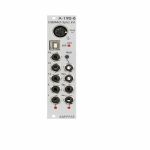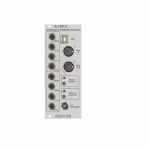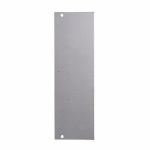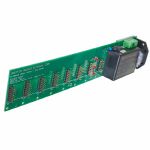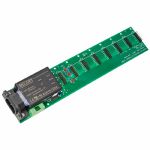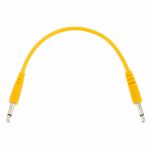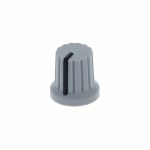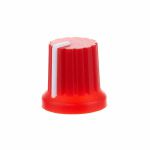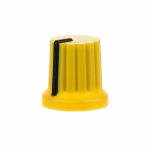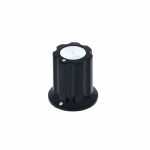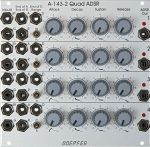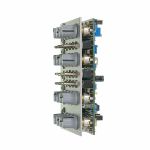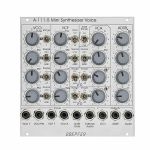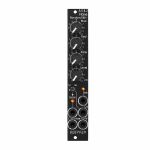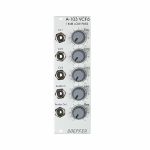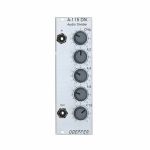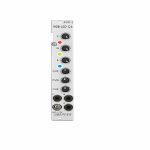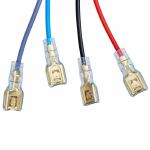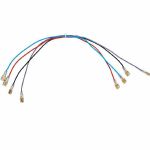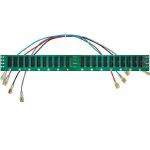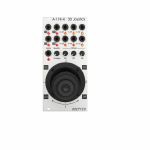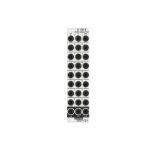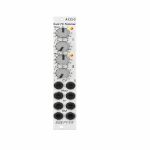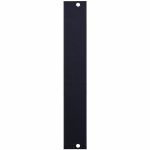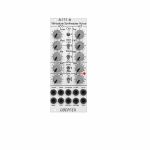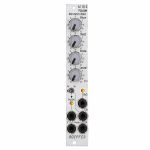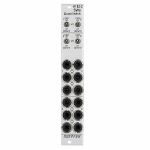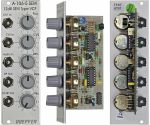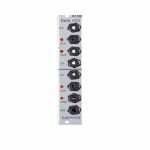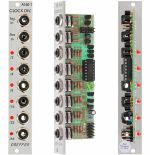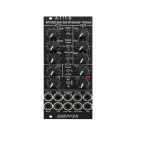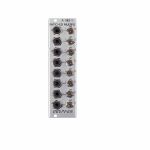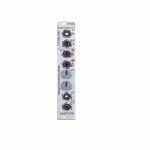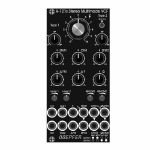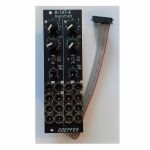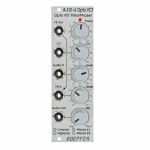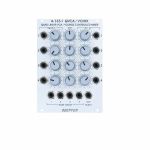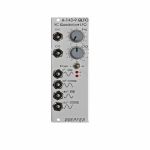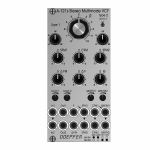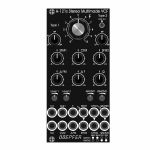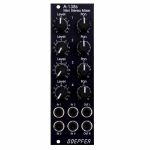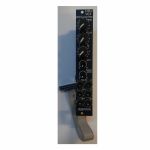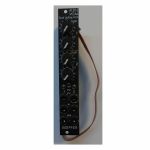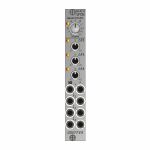安全购物
Studio equipment
Our full range of studio equipment from all the leading equipment and software brands. Guaranteed fast delivery and low prices.
安全购物
DJ equipment
Our full range of DJ equipment from all the leading equipment and software brands. Guaranteed fast delivery and low prices. Visit Juno DJ
Filter
Stock
Coming Soon
Format
Brand
Featured
Price
Tags
Doepfer A-190-8 USB/MIDI-To-Sync Interface Module (silver) (clock generator/MIDI synth module)
Cat: 755412 Rel: 13 Nov 19 • View all Synth modules
MIDI/USB/CV/Gate interface module - 6HP
Notes: USB/MIDI to clock interface that allows for synchronizing clock-driven modules with the MIDI environment. It processes only the Clock, Start, Stop and Continue MIDI commands. It has several clock divider outputs, each one start, stop and reset outputs for controlling sequencers and also an interesting wait function. Input is either a 5-pin DIN socket or USB.
… Read more 1 in stock $122.38
Click for better price!
or call +44 20 7424 1960
quote 755412
quote 755412
Doepfer A-192-2 Dual CV & Gate To MIDI & USB Interface Module (silver) (MIDI/dual/stereo synth module)
Cat: 755414 Rel: 20 Nov 19 • View all Synth modules
Two CV/Gate to MIDI/USB interfaces, each with a common 1V/Oct CV transpose input - 10HP
Notes: Module A-192-2 contains two independent CV/Gate-to-Midi/USB interfaces. For each of the two sub-units these inputs are available:
- Gate Input (min. +5V)
- CVN Input (defines the Midi note number), 1V/octave standard, range 0...+10V (i.e. 10 octaves)
- CVV Input (defines the velocity value assigned to the Midi note message), can be used alternatively for Midi volume (CC#7), range 0...+5V
- CVC Input (free assignable to any Midi control change number), range 0...+5V
For both sub-units a common CV Transpose input is available (1V/octave, range 0...+10V). The voltage applied to this input is added internally to CVN before the Midi note number is generated. It can be used e.g. to transpose two sequences simultaneously by one voltage.
How it works:
Whenever the rising edge of the Gate input is recognized a Midi note on message is generated. The note number corresponds to the sum of the voltages applied to the CVN input and the common CV Transpose Input that is present at the rising edge of the gate signal.
… Read more- Gate Input (min. +5V)
- CVN Input (defines the Midi note number), 1V/octave standard, range 0...+10V (i.e. 10 octaves)
- CVV Input (defines the velocity value assigned to the Midi note message), can be used alternatively for Midi volume (CC#7), range 0...+5V
- CVC Input (free assignable to any Midi control change number), range 0...+5V
For both sub-units a common CV Transpose input is available (1V/octave, range 0...+10V). The voltage applied to this input is added internally to CVN before the Midi note number is generated. It can be used e.g. to transpose two sequences simultaneously by one voltage.
How it works:
Whenever the rising edge of the Gate input is recognized a Midi note on message is generated. The note number corresponds to the sum of the voltages applied to the CVN input and the common CV Transpose Input that is present at the rising edge of the gate signal.
1 in stock $124.45
Click for better price!
or call +44 20 7424 1960
quote 755414
quote 755414
Doepfer A-100B8 Blank Panel 8TE (silver) (blank panel)
Cat: 755427 Rel: 14 Nov 19 • View all Synth Module Accessories
Robust, blank front panel for use with modular racks & other applications - 8HP wide
Notes: Blank panel, 8HP, constructed from anodised aluminium, silver.
… Read more More than 10 in stock $4.14
Doepfer A-100 SSB Small Supply Bus Board & Power Supply (power supply/bus board)
Cat: 755432 Rel: 13 Nov 19 • View all Synth Module Accessories
Power supply & bus board with 8 connectors for modular synthesisers
Notes: A-100SSB is a combination of power supply and bus board with 8 connectors for A-100 modules, planned for applications with up to 8 modules and a max. current of 380 mA.
- Wide range mains voltage input 100-240V AC / 50-60 Hz
- IEC inlet on board for the connection of a suitable mains cable (a suitable mains cable has to be purchased by the customer locally, it's not included with the A-100SSB)
- Switching supply with +12V/380 mA and -12V/380mA for the operation of A-100 modules up to 380 mA total supply current
- Safety cover at the bottom side (covers all elements that lead mains voltage)
- On board fuse
- 8 bus connectors
- LED displays for +12V, -12V and +5V
- Dimensions: about 270 mm (length) x 55 mm (width) x 35 mm (height)
- Several 3mm holes for mounting the unit on a rear panel or bottom plate
… Read more- Wide range mains voltage input 100-240V AC / 50-60 Hz
- IEC inlet on board for the connection of a suitable mains cable (a suitable mains cable has to be purchased by the customer locally, it's not included with the A-100SSB)
- Switching supply with +12V/380 mA and -12V/380mA for the operation of A-100 modules up to 380 mA total supply current
- Safety cover at the bottom side (covers all elements that lead mains voltage)
- On board fuse
- 8 bus connectors
- LED displays for +12V, -12V and +5V
- Dimensions: about 270 mm (length) x 55 mm (width) x 35 mm (height)
- Several 3mm holes for mounting the unit on a rear panel or bottom plate
1 in stock $98.52
Click for better price!
or call +44 20 7424 1960
quote 755432
quote 755432
Cat: 757305 Rel: 28 Nov 19 • View all 音响线材和电源适配器
High-quality patch cable designed for use with Eurorack modules
Notes: - High-grade patch cable designed for modular units
- 3.5mm mono jack plugs
- Length: 15cm
- Yellow finish
… Read more- 3.5mm mono jack plugs
- Length: 15cm
- Yellow finish
More than 10 in stock $1.56
Cat: 757310 Rel: 28 Nov 19 • View all 音响线材和电源适配器
High-quality patch cable designed for use with Eurorack modules
Notes: - High-grade patch cable designed for modular units
- 3.5mm mono jack plugs
- Length: 30cm
- Black finish
… Read more- 3.5mm mono jack plugs
- Length: 30cm
- Black finish
More than 10 in stock $1.56
Cat: 757348 Rel: 28 Nov 19 • View all Synth Module Accessories
Replacement knob for Doepfer modules - grey
Notes: High quality rotary knob, for use with Doepfer or a wide range of modules. Robust design with indented edges. Grey finish.
… Read more6 in stock $1.66
Cat: 757353 Rel: 28 Nov 19 • View all Synth Module Accessories
Replacement knob for Doepfer modules - red
Notes: High quality rotary knob, for use with Doepfer or a wide range of modules. Robust design with indented edges. Red finish.
… Read more 3 in stock $2.07
Cat: 757356 Rel: 28 Nov 19 • View all Synth Module Accessories
Replacement knob for Doepfer modules - green
Notes: High quality rotary knob, for use with Doepfer or a wide range of modules. Robust design with indented edges. Green finish.
… Read more4 in stock $2.59
Cat: 757359 Rel: 28 Nov 19 • View all Synth Module Accessories
Replacement knob for Doepfer modules - yellow
Notes: High quality rotary knob, for use with Doepfer or a wide range of modules. Robust design with indented edges. Yellow finish.
… Read more7 in stock $2.07
Cat: 757360 Rel: 28 Nov 19 • View all Synth Module Accessories
Replacement knob for Doepfer modules - vintage design
Notes: High quality rotary knob, for use with Doepfer or a wide range of modules. Robust design with indented edges. Retro style finish.
… Read moreMore than 10 in stock $3.63
Doepfer A-160-2v Clock/Trigger Divider II Vintage Edition Module (black) (clock modulator/frequency divider synth module)
Cat: 864696 Rel: 14 Mar 22 • View all Synth modules
Module A-160-2 is an enhanced version of the standard clock divider A-160.
Notes: Module A-160-2V is an enhanced version of the standard clock divider A-160. The module is a frequency divider for clock/trigger/gate signals, designed to be a source of lower frequencies, particularly for rhythm uses.
The Clock input will take any digital signal from, eg., an LFO, MIDI sync, or the gate from a MIDI-CV interface. At the outputs, you have access to three sets of seven different sub-divided clock signals, from half the clock frequency down to 1/128. The low/high levels of the output signals are 0V and about +10V.
The A-160-2V also has a reset input. Whenever a reset signal is sensed, all outputs are set to certain levels which depend upon the selected mode.
HP : 4
… Read moreThe Clock input will take any digital signal from, eg., an LFO, MIDI sync, or the gate from a MIDI-CV interface. At the outputs, you have access to three sets of seven different sub-divided clock signals, from half the clock frequency down to 1/128. The low/high levels of the output signals are 0V and about +10V.
The A-160-2V also has a reset input. Whenever a reset signal is sensed, all outputs are set to certain levels which depend upon the selected mode.
HP : 4
5 in stock $107.86
Click for better price!
or call +44 20 7424 1960
quote 864696
quote 864696
Doepfer A-143-2 Quad ADSR Attack/Decay/Sustain/release Module (silver) (envelope generator/quad/LFO/function generator synth module)
Cat: 577755 Rel: 09 Jul 20 • View all Synth modules
Quad ADSR envelope generator synth module, 26HP wide
Notes: The A-143 series of modules contain multiple modulation sources. Module A-143-2 is a four-fold ADSR type envelope generator. Other modules of this series are the Complex Envelope Generator A-143-1 (Quad AD) and the Quad LFO A-143-3.
The module contains 4 independent ADSR-type envelope generators. Each sub-module has available the controls Attack, Decay, Sustain and Release. The three-position Range switch allows to select the desired time range (low - high - medium). The adjustable envelope time ranges from several minutes to some milliseconds. On top of this each sub-module is equipped with three digital outputs (high/low): "End of Attack (EOA)", "End of Decay (EOD)" and "End of Release (EOR)". As soon as the criterion is valid (e.g. end of decay state) the corresponding digital outputs turns to "high". These outputs can be used e.g. to daisy-chain several ADSR sub-modules. For this the digital output in question (EOA, EOD or EOR) has to be connected to the Gate input of the following ADSR. Even automatically running envelopes (pseudo LFOs) or so-called "quadrature envelopes" with cyclical modulations of several ring-shaped, daisy-chained ADSRs are possible. To obtain a pseudo LFO simply the EOD or EOR output has to be connected to the Gate input of the same ADSR.
In addition to the obligatory Gate (G) input for envelope generators each sub-module has available a Retrigger (Rt) input. The retrigger turns the direction to "upward" if the envelope has already reached the decay state while the retrigger pulse occurs. If the envelope is still in the attack phase the retrigger input has no meaning. This a different behaviour from A-140 and A-141!
The Gate inputs of the units 2, 3 and 4 are normalled to the Gate input of unit 1, i.e. Gate input 1 is connected to the switching contacts of the Gate input sockets 2, 3 and 4. Thus one Gate signal applied to Gate input 1 can be used to trigger all four sub-modules simultaneously.
The envelope outputs are displayed with LEDs.
The maximal envelope voltage (Attack/Decay reversal point) is about +8V.
If voltage control of all parameters is required module A-141 is available.
… Read moreThe module contains 4 independent ADSR-type envelope generators. Each sub-module has available the controls Attack, Decay, Sustain and Release. The three-position Range switch allows to select the desired time range (low - high - medium). The adjustable envelope time ranges from several minutes to some milliseconds. On top of this each sub-module is equipped with three digital outputs (high/low): "End of Attack (EOA)", "End of Decay (EOD)" and "End of Release (EOR)". As soon as the criterion is valid (e.g. end of decay state) the corresponding digital outputs turns to "high". These outputs can be used e.g. to daisy-chain several ADSR sub-modules. For this the digital output in question (EOA, EOD or EOR) has to be connected to the Gate input of the following ADSR. Even automatically running envelopes (pseudo LFOs) or so-called "quadrature envelopes" with cyclical modulations of several ring-shaped, daisy-chained ADSRs are possible. To obtain a pseudo LFO simply the EOD or EOR output has to be connected to the Gate input of the same ADSR.
In addition to the obligatory Gate (G) input for envelope generators each sub-module has available a Retrigger (Rt) input. The retrigger turns the direction to "upward" if the envelope has already reached the decay state while the retrigger pulse occurs. If the envelope is still in the attack phase the retrigger input has no meaning. This a different behaviour from A-140 and A-141!
The Gate inputs of the units 2, 3 and 4 are normalled to the Gate input of unit 1, i.e. Gate input 1 is connected to the switching contacts of the Gate input sockets 2, 3 and 4. Thus one Gate signal applied to Gate input 1 can be used to trigger all four sub-modules simultaneously.
The envelope outputs are displayed with LEDs.
The maximal envelope voltage (Attack/Decay reversal point) is about +8V.
If voltage control of all parameters is required module A-141 is available.
1 in stock $187.42
Doepfer A-111-5 Mini Synthesiser Voice Module (silver) (envelope generator/filter/LFO/oscillator/VCA/synth voice synth module)
Cat: 785445 Rel: 10 Sep 20 • View all Synth modules
A complete monophonic synthesiser module (modular version of Dark Energy).
Notes: A fully modular, Eurorack-format version of the excellent Dark Energy synth, the A-111-5 offers VCO, VCF, LFOs, VCA and envelope generator in a compact format. Brilliant value for a starter system.
Supplier's Notes:
Module A-111-5 is a complete monophonic synthesizer module that includes these components (modular version of Dark Energy):
VCO
Manual tune control (with an internal jumper the range can be set to ~ +/-1 half an octave or ~ +/-2.5 octaves)
Range switch -1 / 0 / +1 octave
Frequency range about 10Hz ... 12kHz - FM (frequency modulation) control with modulation source switch (LFO1 / off / ADSR)
Manual pulsewidth control for rectangle waveform
PWM control with modulation source switch (LFO2 / off / ADSR)
Waveform switch (sawtooth / off / triangle)
The sum of the waveform chosen by this switch and the rectangle is fed into the VCF (to turn the rectangle off the PW control has to be set fully CCW)
External CV input for VCO frequency (1V/octave)
External CV input for external PWM of the rectangle - internal CV input for frequency (1V/octave) connected to the A-100 bus via jumper, the jumper can be used to interrupt this internal connection if not wanted
VCF
24 dB low pass
~ 12 octaves frequency range
Manual frequency control
Tracking switch half - off - full (internally connected to the external frequency CV input of the VCO, i.e. the VCF tracks to the VCO if the switch is set to "half" or "full" position)
XM: exponential FM (frequency modulation) control with modulation source switch (LFO2 / off / ADSR)
LM: linear FM (frequency modulation) control to modulate the VCF by the triangle of the VCO in a linear (!) manner
Manual resonance control (up to self oscillation)
External audio input (this signal is added to the VCO signal)
External CV input for filter frequency - 1V/octave tracking for usage of the VCF as a sine wave oscillator (not as precise as the VCO but much better than most of the other filters)
VCA
Manual amplitude control
AM (amplitude modulation) control with modulation source switch (LFO1 / off / ADSR)
External CV input for VCA amplitude - special control scale: exponential scale in the range from about -20dB to -80/90dB, linear scale from about -20dB to 0dB (Remark: this special control scale results in a loudness behaviour that is a bit different from pure linear or exponential VCA)
LFO1 and LFO2
Manual frequency control
Waveform switch (triangle / off / rectangle)
Range switch (low, audio, medium) - LED display (dual green/red color for positive/negative share of the signal)
The inverted LFO1 signal is available as an additional socket (to use the LFO1 signal for external modules)
An internal jumper can be used to select between the LFO1 signal or the inverted LFO1 signal
ADSR
Manual controls for Attack, Decay, Sustain, Release
Range switch (long, short, medium) - blue LED display
ADSR signal is available as an additional socket (to use the ADSR signal for external modules)
Gate input connected to the A-100 bus via jumper, the jumper can be used to interrupt this internal connection if not wanted
Remarks:
As the LFO frequencies can go up to moderate audio range (~ 5kHz) even audio FM effects of VCO (pitch and pulsewidth), VCF and ADSR are possible.
If the VCO is turned off (waveform switch = center position, pulsewidth control = fully CCW) and the VCF resonance is set to maximum the module can be used as a sine oscillator. The sine can be modulated in a linear manner from the triangle wave of the VCO and by LFO2 in an exponential manner at the same time !
From the factory the socket labelled "LFO1" outputs the inverted LFO1 signal. But as the module has several internal pin headers available even another signal may appear at this socket by changing the internal module patch. These six pin headers are available: LFO1 output, LFO2 output, ADSR output, inverter input, inverter output, output socket. The internal default patch is LFO1 -> inverter input, inverter output -> output socket (i.e. socket = inverted LFO1). But even another signal can be patched to this socket (e.g. inverted ADSR, non-inverted LFO1, inverted or non-inverted LFO2). It is also possible to add a blind panel next to the A-111-5 with a couple of sockets that are connected to the corresponding pins of the A-111-5 pc board. The in- and outputs of the VCO, VCF and VCA are not available as pin headers because the VCO, VCF and VCA are internally connected in the circuit which is used in this module.
… Read moreSupplier's Notes:
Module A-111-5 is a complete monophonic synthesizer module that includes these components (modular version of Dark Energy):
VCO
Manual tune control (with an internal jumper the range can be set to ~ +/-1 half an octave or ~ +/-2.5 octaves)
Range switch -1 / 0 / +1 octave
Frequency range about 10Hz ... 12kHz - FM (frequency modulation) control with modulation source switch (LFO1 / off / ADSR)
Manual pulsewidth control for rectangle waveform
PWM control with modulation source switch (LFO2 / off / ADSR)
Waveform switch (sawtooth / off / triangle)
The sum of the waveform chosen by this switch and the rectangle is fed into the VCF (to turn the rectangle off the PW control has to be set fully CCW)
External CV input for VCO frequency (1V/octave)
External CV input for external PWM of the rectangle - internal CV input for frequency (1V/octave) connected to the A-100 bus via jumper, the jumper can be used to interrupt this internal connection if not wanted
VCF
24 dB low pass
~ 12 octaves frequency range
Manual frequency control
Tracking switch half - off - full (internally connected to the external frequency CV input of the VCO, i.e. the VCF tracks to the VCO if the switch is set to "half" or "full" position)
XM: exponential FM (frequency modulation) control with modulation source switch (LFO2 / off / ADSR)
LM: linear FM (frequency modulation) control to modulate the VCF by the triangle of the VCO in a linear (!) manner
Manual resonance control (up to self oscillation)
External audio input (this signal is added to the VCO signal)
External CV input for filter frequency - 1V/octave tracking for usage of the VCF as a sine wave oscillator (not as precise as the VCO but much better than most of the other filters)
VCA
Manual amplitude control
AM (amplitude modulation) control with modulation source switch (LFO1 / off / ADSR)
External CV input for VCA amplitude - special control scale: exponential scale in the range from about -20dB to -80/90dB, linear scale from about -20dB to 0dB (Remark: this special control scale results in a loudness behaviour that is a bit different from pure linear or exponential VCA)
LFO1 and LFO2
Manual frequency control
Waveform switch (triangle / off / rectangle)
Range switch (low, audio, medium) - LED display (dual green/red color for positive/negative share of the signal)
The inverted LFO1 signal is available as an additional socket (to use the LFO1 signal for external modules)
An internal jumper can be used to select between the LFO1 signal or the inverted LFO1 signal
ADSR
Manual controls for Attack, Decay, Sustain, Release
Range switch (long, short, medium) - blue LED display
ADSR signal is available as an additional socket (to use the ADSR signal for external modules)
Gate input connected to the A-100 bus via jumper, the jumper can be used to interrupt this internal connection if not wanted
Remarks:
As the LFO frequencies can go up to moderate audio range (~ 5kHz) even audio FM effects of VCO (pitch and pulsewidth), VCF and ADSR are possible.
If the VCO is turned off (waveform switch = center position, pulsewidth control = fully CCW) and the VCF resonance is set to maximum the module can be used as a sine oscillator. The sine can be modulated in a linear manner from the triangle wave of the VCO and by LFO2 in an exponential manner at the same time !
From the factory the socket labelled "LFO1" outputs the inverted LFO1 signal. But as the module has several internal pin headers available even another signal may appear at this socket by changing the internal module patch. These six pin headers are available: LFO1 output, LFO2 output, ADSR output, inverter input, inverter output, output socket. The internal default patch is LFO1 -> inverter input, inverter output -> output socket (i.e. socket = inverted LFO1). But even another signal can be patched to this socket (e.g. inverted ADSR, non-inverted LFO1, inverted or non-inverted LFO2). It is also possible to add a blind panel next to the A-111-5 with a couple of sockets that are connected to the corresponding pins of the A-111-5 pc board. The in- and outputs of the VCO, VCF and VCA are not available as pin headers because the VCO, VCF and VCA are internally connected in the circuit which is used in this module.
1 in stock $277.96
Doepfer A-118-2V Noise/Random/Sample & Hold Vintage Edition Module (black) (noise/random/sample & hold synth module)
Cat: 790467 Rel: 10 Nov 20 • View all Synth modules
Signal generator module
Notes: Module A-118-2 generates the signals white noise, colored noise, continuous random voltage and stepped random voltage.
The noise signal is generated 100% analog by amplification of the noise of a transistor. White and colored noise are usually used as audio sources. The random voltages are normally used as control voltages (e.g. for filter frequency or any other voltage controlled parameter).
The A-118-2 gives you the ability to mix the relative amounts of Red and Blue noise (low/high frequency component) in the colored noise output.
For the continuous random voltage the rate of change (Rate) and amplitude (Level) of the random voltage can be adjusted. The continuous random voltage is used as source for the S&H/T&H unit. The type of operation can be set to S&H (sample and hold) or T&H (track and hold). When T&H is chosen the output signal follows the input signal as long as the Clock input is "high". As soon as the clock signal changes to "low" the last voltage is stored. When S&H is chosen the input signal is sampled at the rising edge of the Clock signal. For the Clock signal a "digital" signal (e.g. Clock, Gate, rectangle output of an LFO) is required. Dual color LEDs are used to indicates the continuous and stepped random voltages.
Controls:
Blue: share of the high frequencies in the the colored noise output
Red: share of the low frequencies in the the colored noise output
Rate: rate of change of the continuous random voltage
Level: amplitude of the continuous random voltage
TH/SH: switches between T&H und S&H
Inputs and outputs:
RND: continuous random voltage output (with LED display)
TH/SH: stepped random voltage output (with LED display)
Clk: Clock input of the S&H/T&H unit
C Noise: colored noise output
W Noise: white noise output
Important notes:
After power on it takes a few minutes until the two noise signals and the random signals are generated. The module is not faulty when after power on the signals do not appear immediately!
The S&H/T&H function is realized by pure analog circuitry (electronic switch followed by a holding capacitor and buffer). Consequently the output voltage drifts a bit in the holding state because the capacitor is discharged by parasitic resistors. The drift depends also upon environmental conditions like humidity or temperature.
The level of the random voltage changes with the settings of the Blue and Red controls. Especially the Red control affects the random voltage level (which is derived by low pass filtering from the colored noise signal) because the Red control changes the share of the low frequencies in the colored noise signal. The effect of the Blue control is much smaller because it changes the share of the high frequencies in the colored noise signal which are filtered out by the low pass of the random circuitry.
Power consumption: 20mA at +12V and 20mA at -12V
Depth: 40mm
HP : 4
… Read moreThe noise signal is generated 100% analog by amplification of the noise of a transistor. White and colored noise are usually used as audio sources. The random voltages are normally used as control voltages (e.g. for filter frequency or any other voltage controlled parameter).
The A-118-2 gives you the ability to mix the relative amounts of Red and Blue noise (low/high frequency component) in the colored noise output.
For the continuous random voltage the rate of change (Rate) and amplitude (Level) of the random voltage can be adjusted. The continuous random voltage is used as source for the S&H/T&H unit. The type of operation can be set to S&H (sample and hold) or T&H (track and hold). When T&H is chosen the output signal follows the input signal as long as the Clock input is "high". As soon as the clock signal changes to "low" the last voltage is stored. When S&H is chosen the input signal is sampled at the rising edge of the Clock signal. For the Clock signal a "digital" signal (e.g. Clock, Gate, rectangle output of an LFO) is required. Dual color LEDs are used to indicates the continuous and stepped random voltages.
Controls:
Blue: share of the high frequencies in the the colored noise output
Red: share of the low frequencies in the the colored noise output
Rate: rate of change of the continuous random voltage
Level: amplitude of the continuous random voltage
TH/SH: switches between T&H und S&H
Inputs and outputs:
RND: continuous random voltage output (with LED display)
TH/SH: stepped random voltage output (with LED display)
Clk: Clock input of the S&H/T&H unit
C Noise: colored noise output
W Noise: white noise output
Important notes:
After power on it takes a few minutes until the two noise signals and the random signals are generated. The module is not faulty when after power on the signals do not appear immediately!
The S&H/T&H function is realized by pure analog circuitry (electronic switch followed by a holding capacitor and buffer). Consequently the output voltage drifts a bit in the holding state because the capacitor is discharged by parasitic resistors. The drift depends also upon environmental conditions like humidity or temperature.
The level of the random voltage changes with the settings of the Blue and Red controls. Especially the Red control affects the random voltage level (which is derived by low pass filtering from the colored noise signal) because the Red control changes the share of the low frequencies in the colored noise signal. The effect of the Blue control is much smaller because it changes the share of the high frequencies in the colored noise signal which are filtered out by the low pass of the random circuitry.
Power consumption: 20mA at +12V and 20mA at -12V
Depth: 40mm
HP : 4
1 in stock $94.38
Doepfer A-103 VCF6 18dB Low Pass Filter Module (filter synth module)
Cat: 692504 Rel: 18 Jun 18 • View all Synth modules
18dB low pass filter based on a modified Moog cascade - 8HP
Notes: Module A-103 is a voltage controlled low pass filter with 18dB/octave slope. The circuit is based on a modified transistor ladder (Moog ladder) and is a reproduction of the legendary TB303 filter.
As for the rest the A-103 is identical to the A-120 Moog low pass filter (same controls, inputs/outputs) only the filter sound is different.
… Read moreAs for the rest the A-103 is identical to the A-120 Moog low pass filter (same controls, inputs/outputs) only the filter sound is different.
1 in stock $89.19
Click for better price!
or call +44 20 7424 1960
quote 692504
quote 692504
Doepfer A-115 Audio Divider Module (frequency divider synth module)
Cat: 698545 Rel: 15 Aug 18 • View all Synth modules
Fourfold frequency divider for creating up to four sub-octaves - 8HP
Notes: Module A-115 is a four-way frequency divider. The frequency of a signal at the input is halved (half frequency = first sub-octave), quartered (1/4 frequency = second sub-octave), and so on. In this way, the DIVIDER produces four sub-octaves (F/2 down to F/16).
At the output, the A-115 produces a summed mix of the original and the four sub-octaves. There are attenuators to control the amount (i.e. Amplitude) of the original signal and each of the sub-octaves.
Bear in mind that the sub-octaves output by the A-115 are all true square waves. At the output there are always four square waves and the original signal available.
… Read moreAt the output, the A-115 produces a summed mix of the original and the four sub-octaves. There are attenuators to control the amount (i.e. Amplitude) of the original signal and each of the sub-octaves.
Bear in mind that the sub-octaves output by the A-115 are all true square waves. At the output there are always four square waves and the original signal available.
1 in stock $65.33
Click for better price!
or call +44 20 7424 1960
quote 698545
quote 698545
Doepfer A-197-3 RGB LED Stripe Controller Module (silver) (utility synth module)
Cat: 714708 Rel: 25 Mar 19 • View all Synth modules
Controller module for static & dynamic control of RGB LED stripes - 4HP
Notes: Module A-197-3 is a control unit for RGB LED stripes. The LED stripe is glued e.g. to the inner edges of the cases A-100P6/P9/PMS6/PMS9/PMS12 to illuminate the modules and patching statically or dynamically. Especially during live events the dynamic illumination in sync with the sound is an eye-catcher. Each colour (red, green, blue) has available a manual control for the background brightness and a CV input with attenuator that enables the dynamic brightness controlled by other control voltages of the modular system. For example three envelopes can be used which also control the loudness or filtering of sound processing modules. But even other control applications are possible, e.g. LFO, random voltages, clock/gate/trigger signals, sequencer, Midi-to-CV.
… Read more 1 in stock $89.19
Click for better price!
or call +44 20 7424 1960
quote 714708
quote 714708
Cat: 763100 Rel: 31 Jan 20 • View all Synth Module Accessories
Notes: Bus board to connect 14 modules
An assembled and tested bus board, 22 sockets, e.g. for customers who want to built their own case and need a bus board for A-100 modules, includes cables for connection to +/-12V power supply (4 wires with flat connectors on both ends, length about 30cm), but no mechanical parts (e.g. screws, spacers, nuts, washers).
In the new version of the A-100 bus board (labeled Version 6 / 2019) boxed pin headers are used which are equipped with a reverse protection (gap for the "nose" of the socket of the bus cable). When the bus cable coming from the module is connected to the boxed header in question the "nose" has to point to the right. The polarity of the cable is correct if the red wire of the bus cable then points to the bottom (to the continuous line labeled"RED WIRE" on the pc board). If this is not the case please do not connect the module to the bus board ! Otherwise both the module and the power supply (A-100PSU3) may be damaged ! In that case please contact the manufacturer of the module and ask for a suitable bus cable with the correct polarity of the connector.
The bus cables of original A-100 modules manufactured by Doepfer are equipped with suitable bus cables since 2012. Only for older A-100 modules manufactured before 2012 it may happen that the polarity of the 16 pin female connector of the bus cable is wrong (nose points to the left when red wire points to the bottom). This is because in the past unboxed pin headers were used and the position of the "nose" did not matter. In such a case please contact Doepfer or one of their dealers and order a suitable bus cable.
… Read moreAn assembled and tested bus board, 22 sockets, e.g. for customers who want to built their own case and need a bus board for A-100 modules, includes cables for connection to +/-12V power supply (4 wires with flat connectors on both ends, length about 30cm), but no mechanical parts (e.g. screws, spacers, nuts, washers).
In the new version of the A-100 bus board (labeled Version 6 / 2019) boxed pin headers are used which are equipped with a reverse protection (gap for the "nose" of the socket of the bus cable). When the bus cable coming from the module is connected to the boxed header in question the "nose" has to point to the right. The polarity of the cable is correct if the red wire of the bus cable then points to the bottom (to the continuous line labeled"RED WIRE" on the pc board). If this is not the case please do not connect the module to the bus board ! Otherwise both the module and the power supply (A-100PSU3) may be damaged ! In that case please contact the manufacturer of the module and ask for a suitable bus cable with the correct polarity of the connector.
The bus cables of original A-100 modules manufactured by Doepfer are equipped with suitable bus cables since 2012. Only for older A-100 modules manufactured before 2012 it may happen that the polarity of the 16 pin female connector of the bus cable is wrong (nose points to the left when red wire points to the bottom). This is because in the past unboxed pin headers were used and the position of the "nose" did not matter. In such a case please contact Doepfer or one of their dealers and order a suitable bus cable.
1 in stock $36.04
Doepfer A-174-4 3D Joystick Module (silver) (controller/CV modulation/expression module)
Cat: 765892 Rel: 30 Oct 20 • View all Synth modules
Control voltage module - 12HP
Notes: Module A-174-4 modules outputs three control voltages generated by a spring-loaded X/Y cross potentiometer (so-called joy stick) and a Gate signal. The control voltages for X and Y are controlled by the X and Y position of the joystick in the usual way. The third control voltage Z is controlled by the rotation of the spring-loaded joystick knob. The Gate signal is generated by a button at the center/top of the joystick knob.
For each control voltage the non-inverted signal (X, Y, Z) as well as the inverted signal with adjustable offset (-X+XO, -Y+YO, -Z+ZO) are available. The generic joystick control voltages are bipolar, i.e. they range from typ. -5V (lowest position) via 0V (center position) to typ. +5V (highest position). The "Overlap" switches can be used to add a fixed offset voltage of typ. +5V to the non-inverting output in question so that the output voltage range changes to typ. 0...+10V (rather than -5...+5V). That's necessary if e.g. a VCA has to be controlled, which requires a pure positive control voltage range. The switches are named "overlap" because they allow the overlapping of the non-inverting CV output (X, Y, Z) with the inverting output (-X+XO, -Y+YO, -Z+ZO) for crossfading applications. With the overlap switch "on" and appropriate setting of the offset control it's possible to obtain a control voltage range of 0...+10V for the non-inverting output and +10V...0V (i.e. same range but opposite direction) for the inverting output.
The offset voltages which are added to the inverting outputs can be adjusted by means of three small potentiometers. That way different kinds of control voltage ranges are possible, e.g.
-5V ... +5V for the non-inverting output and +5V ... -5V for the inverting output ( Overlap = off, Offset = 0)
0 ... +10V for the non-inverting output and +10V ... 0V for the inverting output ( Overlap = on, Offset = max)
-5V ... +5V for the non-inverting output and +10V ... 0V for the inverting output ( Overlap = off, Offset = max)
0 ... +10V for the non-inverting output and +5V ... -5V for the inverting output ( Overlap = on, Offset = 0)
On top of this the four quadrant voltages Q1, Q2, Q3 and Q4 are available. A quadrant voltage becomes positive when the joystick is positioned in the quadrant in question.
Each CV output is equipped with an LED that displays the present voltage.
Because of the construction height of the joystick (about 7 cm) the module cannot be installed into the cases A-100P6, A-100P9, A-100PMS6, A-100PMS9 and A-100PMS12 during transportation as the depth of the case cover is not sufficient. Into the base cases A-100PB and A-100PMB as well as in all other cases without cover the module can be installed without problems.
HP : 12
… Read moreFor each control voltage the non-inverted signal (X, Y, Z) as well as the inverted signal with adjustable offset (-X+XO, -Y+YO, -Z+ZO) are available. The generic joystick control voltages are bipolar, i.e. they range from typ. -5V (lowest position) via 0V (center position) to typ. +5V (highest position). The "Overlap" switches can be used to add a fixed offset voltage of typ. +5V to the non-inverting output in question so that the output voltage range changes to typ. 0...+10V (rather than -5...+5V). That's necessary if e.g. a VCA has to be controlled, which requires a pure positive control voltage range. The switches are named "overlap" because they allow the overlapping of the non-inverting CV output (X, Y, Z) with the inverting output (-X+XO, -Y+YO, -Z+ZO) for crossfading applications. With the overlap switch "on" and appropriate setting of the offset control it's possible to obtain a control voltage range of 0...+10V for the non-inverting output and +10V...0V (i.e. same range but opposite direction) for the inverting output.
The offset voltages which are added to the inverting outputs can be adjusted by means of three small potentiometers. That way different kinds of control voltage ranges are possible, e.g.
-5V ... +5V for the non-inverting output and +5V ... -5V for the inverting output ( Overlap = off, Offset = 0)
0 ... +10V for the non-inverting output and +10V ... 0V for the inverting output ( Overlap = on, Offset = max)
-5V ... +5V for the non-inverting output and +10V ... 0V for the inverting output ( Overlap = off, Offset = max)
0 ... +10V for the non-inverting output and +5V ... -5V for the inverting output ( Overlap = on, Offset = 0)
On top of this the four quadrant voltages Q1, Q2, Q3 and Q4 are available. A quadrant voltage becomes positive when the joystick is positioned in the quadrant in question.
Each CV output is equipped with an LED that displays the present voltage.
Because of the construction height of the joystick (about 7 cm) the module cannot be installed into the cases A-100P6, A-100P9, A-100PMS6, A-100PMS9 and A-100PMS12 during transportation as the depth of the case cover is not sufficient. Into the base cases A-100PB and A-100PMB as well as in all other cases without cover the module can be installed without problems.
HP : 12
1 in stock $147.58
Doepfer A-130-8 Octal Linear VCA/Voltage Controlled Mixers Slim Line Series Module (silver) (mixer/Quad/VCA synth module)
Cat: 765896 Rel: 28 Jul 20 • View all Synth modules
linear VCA module
Notes: Lots of functionality in a compact format thanks to Doepfer's typically smart approach. Eight linear VCAs with three mixers built in for good measure. Can be used for both audio and CV signals. Versatile.
Supplier notes:
Module A-130-8 contains eight linear voltage controlled amplifiers (VCAs). Each VCA features a control voltage input (CV), a signal input (In) and a signal output (Out). In addition three mixers are included: the socket labelled "1-4" outputs the sum of the VCAs 1-4, the socket labelled "5-8" outputs the sum of the VCAs 5-8, the socket labelled "1-8" outputs the sum of all eight VCAs.
The signal inputs are able to process levels up to 10Vpp without clipping. Each CV input is equipped with a trimming potentiometer that is used to adjust the sensitivity of the CV input in question. In the factory the module is adjusted for the CV range 1...+5V but can be re-adjusted by the user for other control voltage ranges (e.g. 0...+10V).
The amplification range for each single VCA is 0...1. The signals of the sum outputs have a lower amplification to avoid distortion.
The VCAs and mixers are fully DC coupled, i.e. the module can be used for the processing of both audio and control voltage signals. The control voltage and signal inputs can be normalled by means of small solder pads (e.g. 1 > 2 > 3 > 4 and so on, or 1 > 5, 2 > 6, 3 > 7, 4 > 8 for the stereo application mentioned below).
Typical applications:
any kind of VCA application (e.g. voltage controlled attenuation of audio or control voltage signals)
two voltage controlled mixers with four channels each
voltage controlled stereo mixer with four channels each, for this the control voltage inputs have to be correspondingly patched or internally normalled: CV1=CV5 /CV 2=CV6 / CV3=CV7 / CV4=CV8
voltage controlled mixer with eight channels
add-on for the planned Joystick module A-174-4
HP : 6
… Read moreSupplier notes:
Module A-130-8 contains eight linear voltage controlled amplifiers (VCAs). Each VCA features a control voltage input (CV), a signal input (In) and a signal output (Out). In addition three mixers are included: the socket labelled "1-4" outputs the sum of the VCAs 1-4, the socket labelled "5-8" outputs the sum of the VCAs 5-8, the socket labelled "1-8" outputs the sum of all eight VCAs.
The signal inputs are able to process levels up to 10Vpp without clipping. Each CV input is equipped with a trimming potentiometer that is used to adjust the sensitivity of the CV input in question. In the factory the module is adjusted for the CV range 1...+5V but can be re-adjusted by the user for other control voltage ranges (e.g. 0...+10V).
The amplification range for each single VCA is 0...1. The signals of the sum outputs have a lower amplification to avoid distortion.
The VCAs and mixers are fully DC coupled, i.e. the module can be used for the processing of both audio and control voltage signals. The control voltage and signal inputs can be normalled by means of small solder pads (e.g. 1 > 2 > 3 > 4 and so on, or 1 > 5, 2 > 6, 3 > 7, 4 > 8 for the stereo application mentioned below).
Typical applications:
any kind of VCA application (e.g. voltage controlled attenuation of audio or control voltage signals)
two voltage controlled mixers with four channels each
voltage controlled stereo mixer with four channels each, for this the control voltage inputs have to be correspondingly patched or internally normalled: CV1=CV5 /CV 2=CV6 / CV3=CV7 / CV4=CV8
voltage controlled mixer with eight channels
add-on for the planned Joystick module A-174-4
HP : 6
1 in stock $97.71
Doepfer A-133-2 Dual Voltage Controlled VCA/Polarizer/Inverter/Ring Modulator Module (silver) (attenuator/dual/stereo/polarizer/ring modulator/VCA synth module)
Cat: 765897 Rel: 28 Jul 20 • View all Synth modules
VCA/polarizer/inverter/ring modulator module
Notes: A-133-2 is the slim version of the A-133 but has some additional features and improvements available compared to the A-133.
Module A-133-2 can be used for a lot of applications: as a simple VCA, or a voltage controlled polarizer/attuverter, or a voltage controlled inverter up to a DC coupled ring modulator. In principle the module contains two special voltage controlled amplifiers (VCAs) that allow both positive and negative amplification.
The overall amplification is definded by the sum of the voltage generated by the Man control, the external control voltage CV and the position of the CV control which works as an attenuator for the external control voltage. Without external CV the amplification is +1 when the Man control is fully CW. In the center position the amplification is zero and fully CCW it's -1 (i.e. the incoming signal is inverted). By means of the external control voltage CV the manually adjusted amplification can be modulated. CV can be both positive or negative (i.e. bipolar) to obtain positive or negative amplification values controlled by the external CV.
In addition the CV signal can be modulated via the modulation control input Mod by means of another control voltage. The Mod socket is normalled to +5V, i.e. a constant positive voltage is used as modulation CV provided that no plug is inserted into the Mod socket.
The current amplification is displayed by a dual color LED (note: it's not a signal display but indicates the amplification, probably yellow = positive amplification, red = negative amplification)
Application examples:
voltage controlled amplifier (VCA) with pure positive overall amplification (Man + CV)
voltage controlled inverter with pure negative overall amplification (Man + CV)
voltage controlled polarizer/attuverter overall amplification changing between positive and negative (Man + CV)
DC coupled ring modulator with offset feature, the "classical" ring modulator corresponds to Man=0 and symmetrical audio signals for In and CV
additional effects by means of the modulation feature of the CV signal (using the Mod input)
… Read moreModule A-133-2 can be used for a lot of applications: as a simple VCA, or a voltage controlled polarizer/attuverter, or a voltage controlled inverter up to a DC coupled ring modulator. In principle the module contains two special voltage controlled amplifiers (VCAs) that allow both positive and negative amplification.
The overall amplification is definded by the sum of the voltage generated by the Man control, the external control voltage CV and the position of the CV control which works as an attenuator for the external control voltage. Without external CV the amplification is +1 when the Man control is fully CW. In the center position the amplification is zero and fully CCW it's -1 (i.e. the incoming signal is inverted). By means of the external control voltage CV the manually adjusted amplification can be modulated. CV can be both positive or negative (i.e. bipolar) to obtain positive or negative amplification values controlled by the external CV.
In addition the CV signal can be modulated via the modulation control input Mod by means of another control voltage. The Mod socket is normalled to +5V, i.e. a constant positive voltage is used as modulation CV provided that no plug is inserted into the Mod socket.
The current amplification is displayed by a dual color LED (note: it's not a signal display but indicates the amplification, probably yellow = positive amplification, red = negative amplification)
Application examples:
voltage controlled amplifier (VCA) with pure positive overall amplification (Man + CV)
voltage controlled inverter with pure negative overall amplification (Man + CV)
voltage controlled polarizer/attuverter overall amplification changing between positive and negative (Man + CV)
DC coupled ring modulator with offset feature, the "classical" ring modulator corresponds to Man=0 and symmetrical audio signals for In and CV
additional effects by means of the modulation feature of the CV signal (using the Mod input)
1 in stock $97.49
Doepfer A-100B4v Vintage Blank Panel 4TE (black) (blank panel)
Cat: 731210 Rel: 29 May 19 • View all Synth Module Accessories
Robust, blank front panel for use with modular racks & other applications - 4HP wide
Notes: Blank panel, 4HP, constructed from anodised aluminium, black.
… Read more More than 10 in stock $7.01
Doepfer A-100B8v Vintage Blank Panel 8TE (black) (blank panel)
Cat: 731211 Rel: 29 May 19 • View all Synth Module Accessories
Robust, blank front panel for use with modular racks & other applications - 8HP wide
Notes: Blank panel, 8HP, constructed from anodised aluminium, black.
… Read more 2 in stock $8.29
Doepfer A-111-6 Miniature Synthesiser Voice Slim Line Series Module (silver) (synth voice synth module)
Cat: 731937 Rel: 15 Nov 19 • View all Synth modules
Complete miniature monophonic synthesiser module - 10HP
Notes: VCO:
- Tune: manual tune control (with an internal jumper the range can be set to ~ +/-1 half an octave or ~ +/-2.5 octaves)
- Oct: range switch -1 / 0 / +1 octave
- Mod: modulation depth (attenuator wired to the Mod. socket)
- Dest: switch that is used to address the modulation to frequency modulation (position FM) or pulsewidth modulation (positon PM), in centre positon no modulation
- PW: manual pulsewidth control for rectangle waveform, PW can be also modulated by the Mod. input as mentioned above
- Wave: waveform switch (sawtooth / off / triangle), the sum of the waveform chosen by this switch and the rectangle is fed into the VCF (to turn the rectangle off the PW control has to be set fully CCW or fully CW)
- 1V/Oct. (socket): external CV input for VCO frequency (1V/octave)
- Access to internal bus CV (via jumper, optional, please remove the bus jumper if this feature is not used to avoid unwanted frequency modulation as then the unused CV line of the bus works as a kind of antenna)
- Triangle core VCO, frequency range about 32Hz ... 8kHz
Balance unit:
- The balance unit is made of two VCAs which are controlled by the sum of manual Balance control and the balance CV input in the opposite direction.
- The audio input of VCA1 is hard-wired to the VCO output, audio input 2 is connected to the socket Ext.In.
- The output of the balance unit is used as audio input for the VCF
- Bal.: manual balance control, fully CCW the internal VCO is used, fully CW the external signal (Ext.In) is used, at centre position both signals have about the same level
- CV Bal.: CV input for balance (range about 0...+5V)
- Ext. In: external audio input for VCA2, about 5 Vpp level required for similar loudness as the internal VCO
- This socket is normalled to the internal VCO suboctave f/2 signal (rectangle with half the frequency), if no external signal is applied the suboctave signal is used as the second signal for the balance unit
VCF:
- 24 dB low pass
- Frq: manual frequency control
- FM1: frequency modulation depth (attenuator wired to the VCF FM1 socket, the socket is normalled to the internal Envelope signal and then FM1 controls the modulation depth of the internal envelope applied to the filter)
- FM2 (socket) : second CV input for VCF without attenuator (about 1V/octave), can be used e.g. for VCF tracking by connecting the same CV which is used also for the VCO frequency
- Res: manual resonance control (up to self oscillation)
- If the VCO is turned off (waveform switch = centre position, pulsewidth control = fully CCW or CW) and the VCF resonance is set to maximum the module can be used as a sine oscillator, the tracking at socket VCF FM2 is about 1V/octave (not as precise as the VCO but much better than most other filters)
- ~ 11 octaves frequency range (~ 10 Hz ... 20kHz)
VCA:
- Gain: manual amplitude control (initial gain), can be used to open the VCA without envelope signal
- VCA (switch): used to switch between gate and envelope as control signal for the VCA, in centre position the VCA is not controlled by envelope or gate
- Note: when gate is used the VCA is controlled directly by the gate signal (i.e. hard on/off), this may lead to clicking noise under certain conditions (especially with low VCO/VCF frequencies)
- Special control scale: exponential scale in the range from about -20dB to -80/90dB, linear scale from about -20dB to 0dB
- Remark: this special control scale results in a loudness behaviour that is a bit different from pure linear or exponential VCAs
- Out: audio output of the module (= VCA output)
Envelope:
- Gate (socket): Gate input (min. +5V), can be normalled to the bus gate signal by means of a jumper
- Att: manual control for Attack
- D/R: manual control for Decay/Release
- Env. (switch): used to switch between A/D, ADSR and A/R mode of the envelope generator, in centre position (ADSR) the sustain level is fixed to about 50%
- Envelope (socket): envelope output (about +10V)
- CVT (socket): CV input for time control, by means of two internal jumpers one can select which time parameters are controlled by the CVT input (e.g. A only or D/R only or A/D/R) and in which direction (i.e. if an increasing CVT shortens or stretches the time parameter in question)
- Envelope LED display
- Attack time range: ~ 1ms ... 5 sec (can be extended by using the CVT input)
- Decay/Release time range: ~ 1ms ... 15 sec (can be extended by using the CVT input)
… Read more- Tune: manual tune control (with an internal jumper the range can be set to ~ +/-1 half an octave or ~ +/-2.5 octaves)
- Oct: range switch -1 / 0 / +1 octave
- Mod: modulation depth (attenuator wired to the Mod. socket)
- Dest: switch that is used to address the modulation to frequency modulation (position FM) or pulsewidth modulation (positon PM), in centre positon no modulation
- PW: manual pulsewidth control for rectangle waveform, PW can be also modulated by the Mod. input as mentioned above
- Wave: waveform switch (sawtooth / off / triangle), the sum of the waveform chosen by this switch and the rectangle is fed into the VCF (to turn the rectangle off the PW control has to be set fully CCW or fully CW)
- 1V/Oct. (socket): external CV input for VCO frequency (1V/octave)
- Access to internal bus CV (via jumper, optional, please remove the bus jumper if this feature is not used to avoid unwanted frequency modulation as then the unused CV line of the bus works as a kind of antenna)
- Triangle core VCO, frequency range about 32Hz ... 8kHz
Balance unit:
- The balance unit is made of two VCAs which are controlled by the sum of manual Balance control and the balance CV input in the opposite direction.
- The audio input of VCA1 is hard-wired to the VCO output, audio input 2 is connected to the socket Ext.In.
- The output of the balance unit is used as audio input for the VCF
- Bal.: manual balance control, fully CCW the internal VCO is used, fully CW the external signal (Ext.In) is used, at centre position both signals have about the same level
- CV Bal.: CV input for balance (range about 0...+5V)
- Ext. In: external audio input for VCA2, about 5 Vpp level required for similar loudness as the internal VCO
- This socket is normalled to the internal VCO suboctave f/2 signal (rectangle with half the frequency), if no external signal is applied the suboctave signal is used as the second signal for the balance unit
VCF:
- 24 dB low pass
- Frq: manual frequency control
- FM1: frequency modulation depth (attenuator wired to the VCF FM1 socket, the socket is normalled to the internal Envelope signal and then FM1 controls the modulation depth of the internal envelope applied to the filter)
- FM2 (socket) : second CV input for VCF without attenuator (about 1V/octave), can be used e.g. for VCF tracking by connecting the same CV which is used also for the VCO frequency
- Res: manual resonance control (up to self oscillation)
- If the VCO is turned off (waveform switch = centre position, pulsewidth control = fully CCW or CW) and the VCF resonance is set to maximum the module can be used as a sine oscillator, the tracking at socket VCF FM2 is about 1V/octave (not as precise as the VCO but much better than most other filters)
- ~ 11 octaves frequency range (~ 10 Hz ... 20kHz)
VCA:
- Gain: manual amplitude control (initial gain), can be used to open the VCA without envelope signal
- VCA (switch): used to switch between gate and envelope as control signal for the VCA, in centre position the VCA is not controlled by envelope or gate
- Note: when gate is used the VCA is controlled directly by the gate signal (i.e. hard on/off), this may lead to clicking noise under certain conditions (especially with low VCO/VCF frequencies)
- Special control scale: exponential scale in the range from about -20dB to -80/90dB, linear scale from about -20dB to 0dB
- Remark: this special control scale results in a loudness behaviour that is a bit different from pure linear or exponential VCAs
- Out: audio output of the module (= VCA output)
Envelope:
- Gate (socket): Gate input (min. +5V), can be normalled to the bus gate signal by means of a jumper
- Att: manual control for Attack
- D/R: manual control for Decay/Release
- Env. (switch): used to switch between A/D, ADSR and A/R mode of the envelope generator, in centre position (ADSR) the sustain level is fixed to about 50%
- Envelope (socket): envelope output (about +10V)
- CVT (socket): CV input for time control, by means of two internal jumpers one can select which time parameters are controlled by the CVT input (e.g. A only or D/R only or A/D/R) and in which direction (i.e. if an increasing CVT shortens or stretches the time parameter in question)
- Envelope LED display
- Attack time range: ~ 1ms ... 5 sec (can be extended by using the CVT input)
- Decay/Release time range: ~ 1ms ... 15 sec (can be extended by using the CVT input)
1 in stock $174.23
Doepfer A-118-2 Noise/Random/Sample & Hold Slim Line Module (silver) (noise/random/sample & hold module)
Cat: 731938 Rel: 10 Jun 19 • View all Synth modules
Noise, random, sample & hold module - 4HP
Notes: Module A-118-2 is the slim version of module A-118-1 and offers essentially the same features as the A-118-1. But the distances between the controls are smaller and rubberized small-sized knobs are used. In return the front panel has 4 HP only which is half the width of the A-118-1. The module is primarily planned for applications where only limited space is available. The functional difference between A-118-1 and A-118-2 is the additional T&H/S&H unit which is not included in the A-118-1.
The module generates the signals white noise, colored noise, continuous random voltage and stepped random voltage (derived from the continuous random voltage by means of a S&H/T&H unit).
The noise signal is generated 100% analog by amplification of the noise of a transistor. White and colored noise are usually used as audio sources. The random voltages are normally used as control voltages (e.g. for filter frequency or any other voltage controlled parameter).
The A-118-2 gives you the ability to mix the relative amounts of Red (low frequency component) and Blue noise (high frequency component) in the colored noise output.
For the continuous random voltage the rate of change (Rate) and amplitude (Level) of the random voltage can be adjusted. The continuous random voltage is derived from the colored noise signal by low pass filtering. Consequently the settings of the controls for the colored noise (Blue, Red) affect the behavior of the random voltage! A dual color LED (red = positive / yellow = negative output voltage) indicates the continuous random voltage.
The continuous random voltage is used as source for the S&H/T&H unit. The type of operation can be set to S&H (sample and hold) or T&H (track and hold). When T&H is chosen the output signal follows the input signal (= continuous random voltage) as long as the Clock input is "high". As soon as the clock signal changes to "low" the last voltage is stored. When S&H is chosen the input signal (= continuous random voltage) is sampled at the rising edge of the Clock signal.
For the Clock signal a "digital" signal (e.g. Clock, Gate, rectangle output of an LFO) is required. It does not work with slowly changing continuous CV signals. Another dual color LED (red = positive / yellow = negative output voltage) indicates the stepped random voltage.
Controls:
Blue: share of the high frequencies in the the colored noise output
Red: share of the low frequencies in the the colored noise output
Rate: rate of change of the continuous random voltage
Level: amplitude of the continuous random voltage
TH/SH: switches between T&H and S&H
Inputs and outputs:
RND: continuous random voltage output (with LED display)
TH/SH: stepped random voltage output (with LED display)
Clk: Clock input of the S&H/T&H unit
C Noise: colored noise output
W Noise: white noise output
Important notes:
After power on it takes a few minutes until the two noise signals and the random signals are generated. The module is not faulty when after power on the signals do not appear immediately!
The S&H/T&H function is realized by pure analog circuitry (electronic switch followed by a holding capacitor and buffer). Consequently the output voltage drifts a bit in the holding state because the capacitor is discharged by parasitic resistors. The drift depends also upon environmental conditions like humidity or temperature.
Dimensions
4 HP
40 mm deep
Current Draw
20 mA +12V
20 mA -12V
… Read moreThe module generates the signals white noise, colored noise, continuous random voltage and stepped random voltage (derived from the continuous random voltage by means of a S&H/T&H unit).
The noise signal is generated 100% analog by amplification of the noise of a transistor. White and colored noise are usually used as audio sources. The random voltages are normally used as control voltages (e.g. for filter frequency or any other voltage controlled parameter).
The A-118-2 gives you the ability to mix the relative amounts of Red (low frequency component) and Blue noise (high frequency component) in the colored noise output.
For the continuous random voltage the rate of change (Rate) and amplitude (Level) of the random voltage can be adjusted. The continuous random voltage is derived from the colored noise signal by low pass filtering. Consequently the settings of the controls for the colored noise (Blue, Red) affect the behavior of the random voltage! A dual color LED (red = positive / yellow = negative output voltage) indicates the continuous random voltage.
The continuous random voltage is used as source for the S&H/T&H unit. The type of operation can be set to S&H (sample and hold) or T&H (track and hold). When T&H is chosen the output signal follows the input signal (= continuous random voltage) as long as the Clock input is "high". As soon as the clock signal changes to "low" the last voltage is stored. When S&H is chosen the input signal (= continuous random voltage) is sampled at the rising edge of the Clock signal.
For the Clock signal a "digital" signal (e.g. Clock, Gate, rectangle output of an LFO) is required. It does not work with slowly changing continuous CV signals. Another dual color LED (red = positive / yellow = negative output voltage) indicates the stepped random voltage.
Controls:
Blue: share of the high frequencies in the the colored noise output
Red: share of the low frequencies in the the colored noise output
Rate: rate of change of the continuous random voltage
Level: amplitude of the continuous random voltage
TH/SH: switches between T&H and S&H
Inputs and outputs:
RND: continuous random voltage output (with LED display)
TH/SH: stepped random voltage output (with LED display)
Clk: Clock input of the S&H/T&H unit
C Noise: colored noise output
W Noise: white noise output
Important notes:
After power on it takes a few minutes until the two noise signals and the random signals are generated. The module is not faulty when after power on the signals do not appear immediately!
The S&H/T&H function is realized by pure analog circuitry (electronic switch followed by a holding capacitor and buffer). Consequently the output voltage drifts a bit in the holding state because the capacitor is discharged by parasitic resistors. The drift depends also upon environmental conditions like humidity or temperature.
Dimensions
4 HP
40 mm deep
Current Draw
20 mA +12V
20 mA -12V
2 in stock $86.08
Click for better price!
or call +44 20 7424 1960
quote 731938
quote 731938
Doepfer A-145-4 LFOs Quad Low Frequency Oscillator Slim Line Module (silver) (LFO/quad synth module)
Cat: 731949 Rel: 10 Jun 19 • View all Synth modules
Quad low frequency oscillator - 4HP
Notes: Module A-145-4 is a simple quad LFO (Low Frequency Oscillator). Not a very "exciting" module, just a bread-and-butter device and a simple demon for work. Virtually in every modular system several LFOs are required for modulation purposes. The module contains four simple LFOs with the waveforms triangle and rectangle. A dual colour LED (red = positive / yellow = negative output voltage) indicates the triangle output of each LFO. The frequency range can be chosen for each LFO individually by means of a jumper between about 50 Hz ... 0.04 Hz (about 20 seconds, jumper removed) and about 2Hz ... 0.002 (about 8 minutes, jumper installed).
The module can be treated as a slimmed version of the quad LFO A-143-3 as it has similar features available. But the distances between the controls are smaller and rubberized small-sized knobs are used. In return the front panel has 4 HP only which is less than one third of the A-143-3. The module is primarily planned for applications where only limited space is available. The functional difference compared to the A-143-3 are the missing sawtooth outputs and frequency range switches.
… Read moreThe module can be treated as a slimmed version of the quad LFO A-143-3 as it has similar features available. But the distances between the controls are smaller and rubberized small-sized knobs are used. In return the front panel has 4 HP only which is less than one third of the A-143-3. The module is primarily planned for applications where only limited space is available. The functional difference compared to the A-143-3 are the missing sawtooth outputs and frequency range switches.
4 in stock $81.42
Click for better price!
or call +44 20 7424 1960
quote 731949
quote 731949
Doepfer A-182-2 Quad Passive Switch Slim Line Series Module (silver) (quad/switch synth module)
Cat: 731951 Rel: 11 Jun 19 • View all Synth modules
Quad passive switch - 4HP
Notes: A-182-2 is a simple passive module that contains four changeover switches, which are used to connect or disconnect the sockets of the corresponding socket triplet:
- In the upper position of the switch the upper socket of the corresponding socket triplet is connected to the centre socket
- In the lower position of the switch the lower socket of the corresponding socket triplet is connected to the centre socket
- In the centre position of the switch the sockets are not connected
Each unit of the module can be used to switch between two signals or to interrupt/connect a signal. In the last case the third socket of the triplet is not used.
The module is fully passive and both audio or control signals can be switched.
… Read more- In the upper position of the switch the upper socket of the corresponding socket triplet is connected to the centre socket
- In the lower position of the switch the lower socket of the corresponding socket triplet is connected to the centre socket
- In the centre position of the switch the sockets are not connected
Each unit of the module can be used to switch between two signals or to interrupt/connect a signal. In the last case the third socket of the triplet is not used.
The module is fully passive and both audio or control signals can be switched.
1 in stock $62.22
Click for better price!
or call +44 20 7424 1960
quote 731951
quote 731951
Doepfer A-106-5 SEM 12dB SEM Type VCF Module (silver) (filter synth module)
Cat: 577753 Rel: 06 Jun 19 • View all Synth modules
12dB multi-mode filter - 8HP
Notes: Module A-106-5 is a 12dB multimode filter that is based on the filter circuit of the Oberheim SEM module.
The filter is equipped with a band pass output and a combined low/notch/high pass output. For this output a control knob defines the relation between low and high pass signal. If both signals appear at the same level (i.e. middle position of the Mix knob) one obtains a notch filter. Otherwise the low or high pass signal predominates.
The module does not feature self-oscillation in contrast to most of the other filters of the A-100 system.
The module generates a distorted audio signal if the level control is set to about 50% (i.e. centre position) or more with A-100 standard signals like VCOs.
… Read moreThe filter is equipped with a band pass output and a combined low/notch/high pass output. For this output a control knob defines the relation between low and high pass signal. If both signals appear at the same level (i.e. middle position of the Mix knob) one obtains a notch filter. Otherwise the low or high pass signal predominates.
The module does not feature self-oscillation in contrast to most of the other filters of the A-100 system.
The module generates a distorted audio signal if the level control is set to about 50% (i.e. centre position) or more with A-100 standard signals like VCOs.
1 in stock $80.89
Doepfer A-150 Dual Voltage Controlled Switch Module (silver) (dual/stereo/switch synth module)
Cat: 745778 Rel: 10 Sep 19 • View all Synth modules
Two independent voltage controlled switches in one module - 4HP
Notes: Module A-150-1 (Dual VCS) contains two separate voltage-controlled switches.
Each switch has a control voltage input, a common Out / Input, and two In / Outputs. The switches are bi-directional: they can work in both directions, so can connect one input to either of two outputs, or either of two inputs to one output. Voltages in the range -8V...+8V at the O/I resp. I/O sockets can be processed by the module.
Two LEDs show which in / output is active (i.e. which is connected to the common out / input).
… Read moreEach switch has a control voltage input, a common Out / Input, and two In / Outputs. The switches are bi-directional: they can work in both directions, so can connect one input to either of two outputs, or either of two inputs to one output. Voltages in the range -8V...+8V at the O/I resp. I/O sockets can be processed by the module.
Two LEDs show which in / output is active (i.e. which is connected to the common out / input).
1 in stock $61.18
Click for better price!
or call +44 20 7424 1960
quote 745778
quote 745778
Doepfer A-160-5v Voltage Controlled Clock Multiplier & Ratcheting Controller Module (vintage edition) (synth module)
Cat: 745789 Rel: 10 Sep 19 • View all Synth modules
Voltage-controlled clock multiplier with CV or manual control - 4HP
Notes: Module A-160-5 is a voltage controlled clock multiplier. The incoming clock signal (socket Clock In) is multiplied by a factor that depends upon the control voltage on socket CV In (0...+5V) and the position of the Mode switch. The multiplied clock signal is available at the socket Clock Out. According to the position of the Mode switch different clock multiplying factors are assigned to the control voltage. With 0V CV no clock output is generated. This state is indicated by "all LEDs off". With increasing CV integer factors (left position of the mode switch), power of two factors (middle position) or a mix of both (right position) are obtained. Nine LEDs are used to show the currently selected multiplying factor. In addition two LEDs are used to display the incoming and outgoing clock signal.
A manual control is used to adjust the clock multiplication factor manually without the need of an external control voltage. The voltage generated by this control ("Manual") is normalled to the CV In socket. As long as no plug is inserted into the CV In socket the clock multiplication factor is adjusted by means of the manual control knob and displayed by the LEDs. For dynamic applications (like the ratcheting function described below) the manually generated CV is overwritten by the external CV which has to be fed into the CV In socket.
The module can be used for all kind of clock multiplying applications. One important example is the generation of so-called ratcheting sequences. The band Tangerine Dream is famous for this kind of sequences. A normal sequencer generates only one gate signal per step. A ratcheting sequence may have also more than one gate pulses per step. This function can be obtained by using the A-160-5: one CV output of the sequencer is used to define the number of gate pulses per step. If the control of the step in question is fully CCW the generated CV is 0V and no gate signal is generated (mute of the step). When the control of the step in question is turned clockwise one, two or more gate pulses are generated depending upon the position of the mode switch and the voltage generated by the CV at this step.
Technical note: Due to the nature of clock multiplying it takes a few input clock pulses until the clock output is stable. One has to average a few input clock pulses to generate the multiplied clock output signal. Even when the input clock frequency changes it will take a few cycles until the output clock signal is correct as the module cannot foresee the future of the clock input signal. The generated clock output signal is derived from the last few cycles of the clock input signal. Consequently the module should be driven only by a clock signal with constant or slowly changing frequency.
… Read moreA manual control is used to adjust the clock multiplication factor manually without the need of an external control voltage. The voltage generated by this control ("Manual") is normalled to the CV In socket. As long as no plug is inserted into the CV In socket the clock multiplication factor is adjusted by means of the manual control knob and displayed by the LEDs. For dynamic applications (like the ratcheting function described below) the manually generated CV is overwritten by the external CV which has to be fed into the CV In socket.
The module can be used for all kind of clock multiplying applications. One important example is the generation of so-called ratcheting sequences. The band Tangerine Dream is famous for this kind of sequences. A normal sequencer generates only one gate signal per step. A ratcheting sequence may have also more than one gate pulses per step. This function can be obtained by using the A-160-5: one CV output of the sequencer is used to define the number of gate pulses per step. If the control of the step in question is fully CCW the generated CV is 0V and no gate signal is generated (mute of the step). When the control of the step in question is turned clockwise one, two or more gate pulses are generated depending upon the position of the mode switch and the voltage generated by the CV at this step.
Technical note: Due to the nature of clock multiplying it takes a few input clock pulses until the clock output is stable. One has to average a few input clock pulses to generate the multiplied clock output signal. Even when the input clock frequency changes it will take a few cycles until the output clock signal is correct as the module cannot foresee the future of the clock input signal. The generated clock output signal is derived from the last few cycles of the clock input signal. Consequently the module should be driven only by a clock signal with constant or slowly changing frequency.
3 in stock $107.86
Click for better price!
or call +44 20 7424 1960
quote 745789
quote 745789
Doepfer A-160-1 Clock/Trigger Divider Module (clock modulator synth module)
Cat: 577765 Rel: 10 Sep 19 • View all Synth modules
Frequency divider for clock, trigger & gate signals - 4HP
Notes: Module A-160 is a frequency divider for clock/trigger/gate signals, designed to be a source of lower frequencies, particularly for rhythm uses. The Trigger input will take clock signals from, e.g. an LFO, MIDI sync, or the gate from a MIDI-CV interface.
At the outputs, you have access to the sub-divided clock signals, from half the clock frequency down to 1/64. The low/high levels of the output signals are 0V and about +10V.
The A-160 also has a reset input. Whenever a reset signal is sensed, all outputs are set to zero, until the reset voltage disappears.
The Clock Divider can be used in combination with the A-161 Clock Sequencer to produce stepped sequences with a length of from one to eight events.
… Read moreAt the outputs, you have access to the sub-divided clock signals, from half the clock frequency down to 1/64. The low/high levels of the output signals are 0V and about +10V.
The A-160 also has a reset input. Whenever a reset signal is sensed, all outputs are set to zero, until the reset voltage disappears.
The Clock Divider can be used in combination with the A-161 Clock Sequencer to produce stepped sequences with a length of from one to eight events.
1 in stock $60.94
Doepfer A-111-6v Miniature Synthesiser Voice Vintage Edition Module (black) (synth voice synth module)
Cat: 749811 Rel: 15 Nov 19 • View all Synth modules
Complete miniature monophonic synthesiser module - 10HP
Notes: VCO:
- Tune: manual tune control (with an internal jumper the range can be set to ~ +/-1 half an octave or ~ +/-2.5 octaves)
- Oct: range switch -1 / 0 / +1 octave
- Mod: modulation depth (attenuator wired to the Mod. socket)
- Dest: switch that is used to address the modulation to frequency modulation (position FM) or pulsewidth modulation (positon PM), in centre positon no modulation
- PW: manual pulsewidth control for rectangle waveform, PW can be also modulated by the Mod. input as mentioned above
- Wave: waveform switch (sawtooth / off / triangle), the sum of the waveform chosen by this switch and the rectangle is fed into the VCF (to turn the rectangle off the PW control has to be set fully CCW or fully CW)
- 1V/Oct. (socket): external CV input for VCO frequency (1V/octave)
- Access to internal bus CV (via jumper, optional, please remove the bus jumper if this feature is not used to avoid unwanted frequency modulation as then the unused CV line of the bus works as a kind of antenna)
- Triangle core VCO, frequency range about 32Hz ... 8kHz
Balance unit:
- The balance unit is made of two VCAs which are controlled by the sum of manual Balance control and the balance CV input in the opposite direction.
- The audio input of VCA1 is hard-wired to the VCO output, audio input 2 is connected to the socket Ext.In.
- The output of the balance unit is used as audio input for the VCF
- Bal.: manual balance control, fully CCW the internal VCO is used, fully CW the external signal (Ext.In) is used, at centre position both signals have about the same level
- CV Bal.: CV input for balance (range about 0...+5V)
- Ext. In: external audio input for VCA2, about 5 Vpp level required for similar loudness as the internal VCO
- This socket is normalled to the internal VCO suboctave f/2 signal (rectangle with half the frequency), if no external signal is applied the suboctave signal is used as the second signal for the balance unit
VCF:
- 24 dB low pass
- Frq: manual frequency control
- FM1: frequency modulation depth (attenuator wired to the VCF FM1 socket, the socket is normalled to the internal Envelope signal and then FM1 controls the modulation depth of the internal envelope applied to the filter)
- FM2 (socket) : second CV input for VCF without attenuator (about 1V/octave), can be used e.g. for VCF tracking by connecting the same CV which is used also for the VCO frequency
- Res: manual resonance control (up to self oscillation)
- If the VCO is turned off (waveform switch = centre position, pulsewidth control = fully CCW or CW) and the VCF resonance is set to maximum the module can be used as a sine oscillator, the tracking at socket VCF FM2 is about 1V/octave (not as precise as the VCO but much better than most other filters)
- ~ 11 octaves frequency range (~ 10 Hz ... 20kHz)
VCA:
- Gain: manual amplitude control (initial gain), can be used to open the VCA without envelope signal
- VCA (switch): used to switch between gate and envelope as control signal for the VCA, in centre position the VCA is not controlled by envelope or gate
- Note: when gate is used the VCA is controlled directly by the gate signal (i.e. hard on/off), this may lead to clicking noise under certain conditions (especially with low VCO/VCF frequencies)
- Special control scale: exponential scale in the range from about -20dB to -80/90dB, linear scale from about -20dB to 0dB
- Remark: this special control scale results in a loudness behaviour that is a bit different from pure linear or exponential VCAs
- Out: audio output of the module (= VCA output)
Envelope:
- Gate (socket): Gate input (min. +5V), can be normalled to the bus gate signal by means of a jumper
- Att: manual control for Attack
- D/R: manual control for Decay/Release
- Env. (switch): used to switch between A/D, ADSR and A/R mode of the envelope generator, in centre position (ADSR) the sustain level is fixed to about 50%
- Envelope (socket): envelope output (about +10V)
- CVT (socket): CV input for time control, by means of two internal jumpers one can select which time parameters are controlled by the CVT input (e.g. A only or D/R only or A/D/R) and in which direction (i.e. if an increasing CVT shortens or stretches the time parameter in question)
- Envelope LED display
- Attack time range: ~ 1ms ... 5 sec (can be extended by using the CVT input)
- Decay/Release time range: ~ 1ms ... 15 sec (can be extended by using the CVT input)
… Read more- Tune: manual tune control (with an internal jumper the range can be set to ~ +/-1 half an octave or ~ +/-2.5 octaves)
- Oct: range switch -1 / 0 / +1 octave
- Mod: modulation depth (attenuator wired to the Mod. socket)
- Dest: switch that is used to address the modulation to frequency modulation (position FM) or pulsewidth modulation (positon PM), in centre positon no modulation
- PW: manual pulsewidth control for rectangle waveform, PW can be also modulated by the Mod. input as mentioned above
- Wave: waveform switch (sawtooth / off / triangle), the sum of the waveform chosen by this switch and the rectangle is fed into the VCF (to turn the rectangle off the PW control has to be set fully CCW or fully CW)
- 1V/Oct. (socket): external CV input for VCO frequency (1V/octave)
- Access to internal bus CV (via jumper, optional, please remove the bus jumper if this feature is not used to avoid unwanted frequency modulation as then the unused CV line of the bus works as a kind of antenna)
- Triangle core VCO, frequency range about 32Hz ... 8kHz
Balance unit:
- The balance unit is made of two VCAs which are controlled by the sum of manual Balance control and the balance CV input in the opposite direction.
- The audio input of VCA1 is hard-wired to the VCO output, audio input 2 is connected to the socket Ext.In.
- The output of the balance unit is used as audio input for the VCF
- Bal.: manual balance control, fully CCW the internal VCO is used, fully CW the external signal (Ext.In) is used, at centre position both signals have about the same level
- CV Bal.: CV input for balance (range about 0...+5V)
- Ext. In: external audio input for VCA2, about 5 Vpp level required for similar loudness as the internal VCO
- This socket is normalled to the internal VCO suboctave f/2 signal (rectangle with half the frequency), if no external signal is applied the suboctave signal is used as the second signal for the balance unit
VCF:
- 24 dB low pass
- Frq: manual frequency control
- FM1: frequency modulation depth (attenuator wired to the VCF FM1 socket, the socket is normalled to the internal Envelope signal and then FM1 controls the modulation depth of the internal envelope applied to the filter)
- FM2 (socket) : second CV input for VCF without attenuator (about 1V/octave), can be used e.g. for VCF tracking by connecting the same CV which is used also for the VCO frequency
- Res: manual resonance control (up to self oscillation)
- If the VCO is turned off (waveform switch = centre position, pulsewidth control = fully CCW or CW) and the VCF resonance is set to maximum the module can be used as a sine oscillator, the tracking at socket VCF FM2 is about 1V/octave (not as precise as the VCO but much better than most other filters)
- ~ 11 octaves frequency range (~ 10 Hz ... 20kHz)
VCA:
- Gain: manual amplitude control (initial gain), can be used to open the VCA without envelope signal
- VCA (switch): used to switch between gate and envelope as control signal for the VCA, in centre position the VCA is not controlled by envelope or gate
- Note: when gate is used the VCA is controlled directly by the gate signal (i.e. hard on/off), this may lead to clicking noise under certain conditions (especially with low VCO/VCF frequencies)
- Special control scale: exponential scale in the range from about -20dB to -80/90dB, linear scale from about -20dB to 0dB
- Remark: this special control scale results in a loudness behaviour that is a bit different from pure linear or exponential VCAs
- Out: audio output of the module (= VCA output)
Envelope:
- Gate (socket): Gate input (min. +5V), can be normalled to the bus gate signal by means of a jumper
- Att: manual control for Attack
- D/R: manual control for Decay/Release
- Env. (switch): used to switch between A/D, ADSR and A/R mode of the envelope generator, in centre position (ADSR) the sustain level is fixed to about 50%
- Envelope (socket): envelope output (about +10V)
- CVT (socket): CV input for time control, by means of two internal jumpers one can select which time parameters are controlled by the CVT input (e.g. A only or D/R only or A/D/R) and in which direction (i.e. if an increasing CVT shortens or stretches the time parameter in question)
- Envelope LED display
- Attack time range: ~ 1ms ... 5 sec (can be extended by using the CVT input)
- Decay/Release time range: ~ 1ms ... 15 sec (can be extended by using the CVT input)
2 in stock $171.79
Doepfer A-182-1 Switched Multiples Module (switch/multiple synth module)
Cat: 751724 Rel: 23 Oct 19 • View all Synth modules
Eurorack passive multi-connector - 6HP
Notes: Module A-182-1 is a simple passive multi-connector similar to the multiples modules A-180-1/A-180-2. In contrast to modules A-180-1/2 each socket is equipped with a 3-position switch that allows to connect the corresponding socket to the internal bus #1 (left position), bus #2 (right position) or to turn the socket off (centre position).
Examples:
- All switches in left position or all switches in right position: 8-fold multiple
- Four switches in left position and four switches in right position: two 4-fold multiple
- X switches in left position, Y switches in right position and Z switches in centre position: two separate multiples with some sockets turned off
… Read moreExamples:
- All switches in left position or all switches in right position: 8-fold multiple
- Four switches in left position and four switches in right position: two 4-fold multiple
- X switches in left position, Y switches in right position and Z switches in centre position: two separate multiples with some sockets turned off
2 in stock $54.84
Doepfer A-184-2 Voltage Controlled Crossfader & Triangle To Sine Waveshaper Slim Line Series Module (silver) (VCA/waveshaper/mixer synth module)
Cat: 751758 Rel: 23 Oct 19 • View all Synth modules
Sine converter/VC crossfader - 4HP
Notes: Module A-184-2 is the combination of two functions and planned primarily as an expansion module for VCOs or LFOs (e.g. A-110-1, A-110-2, A-145, A-147-2).
Triangle-to-Sine Waveshaper:
The upper section is a very precise triangle-to-sine converter (thanks to Tim Stinchcombe who recommended this circuit). It can be used to convert any triangle waveform into a (nearly) perfect sine. The converter is much better than the simple diode converter used in the A-110-1, A-111-1, A-145 and A-147-2. Two trimming potentiometers are used to optimize the sine shape. The converter should be assigned to one VCO or LFO because the trimming potentiometers have to be re-adjusted if the input level or DC offset of the input signal changes. If the trimming potentiometers are deliberately mis-adjusted it can be used also as a waveshaper for non-sine waveforms (e.g. sine-shaped at the top of the signal and a peak at the bottom, even voltage controlled by applying an additional voltage to the waveshaping circuit, "circuit-bending" notes will be available).
The waveform converter is DC coupled and can be used also for low frequencies (e.g. LFO triangle waves).
Voltage Controlled Crossfader:
The lower section is a voltage controlled crossfader. It has two inputs A and B. The two signals are mixed together with variable percentage. When the manual control CF is fully CCW only signal A appears at the CF Out socket. When the manual control CF is fully CW only signal B appears at the CF Out socket. In the centre position of the manual control both signal appear with the same level. In addition a control voltage input CV with attenuator is available to enable voltage control of the crossfade.
Two LEDs display the crossfading shares of input A and B.
The crossfader uses two high quality VCAs (SSM2164). Inputs and outputs are DC coupled. Consequently it can be used for audio signals and slowly varying control voltages as well.
The sockets of the upper section (triangle and sine) are normalled to the inputs A and B of the crossfader section. That way the crossfader is used to fade between triangle and sine of the VCO or LFO connected to the waveshaper. If other signals are plugged into the input sockets A and B these signals are used for crossfading.
The main application is to fade between two different waveforms of a VCO or LFO or two different VCF outputs. But the module can be used for any other signals too as the waveshaper and crossfader sections are independent apart from the normalled sockets.
… Read moreTriangle-to-Sine Waveshaper:
The upper section is a very precise triangle-to-sine converter (thanks to Tim Stinchcombe who recommended this circuit). It can be used to convert any triangle waveform into a (nearly) perfect sine. The converter is much better than the simple diode converter used in the A-110-1, A-111-1, A-145 and A-147-2. Two trimming potentiometers are used to optimize the sine shape. The converter should be assigned to one VCO or LFO because the trimming potentiometers have to be re-adjusted if the input level or DC offset of the input signal changes. If the trimming potentiometers are deliberately mis-adjusted it can be used also as a waveshaper for non-sine waveforms (e.g. sine-shaped at the top of the signal and a peak at the bottom, even voltage controlled by applying an additional voltage to the waveshaping circuit, "circuit-bending" notes will be available).
The waveform converter is DC coupled and can be used also for low frequencies (e.g. LFO triangle waves).
Voltage Controlled Crossfader:
The lower section is a voltage controlled crossfader. It has two inputs A and B. The two signals are mixed together with variable percentage. When the manual control CF is fully CCW only signal A appears at the CF Out socket. When the manual control CF is fully CW only signal B appears at the CF Out socket. In the centre position of the manual control both signal appear with the same level. In addition a control voltage input CV with attenuator is available to enable voltage control of the crossfade.
Two LEDs display the crossfading shares of input A and B.
The crossfader uses two high quality VCAs (SSM2164). Inputs and outputs are DC coupled. Consequently it can be used for audio signals and slowly varying control voltages as well.
The sockets of the upper section (triangle and sine) are normalled to the inputs A and B of the crossfader section. That way the crossfader is used to fade between triangle and sine of the VCO or LFO connected to the waveshaper. If other signals are plugged into the input sockets A and B these signals are used for crossfading.
The main application is to fade between two different waveforms of a VCO or LFO or two different VCF outputs. But the module can be used for any other signals too as the waveshaper and crossfader sections are independent apart from the normalled sockets.
2 in stock $82.97
Doepfer A-121sV Stereo Multimode Filter Vintage Edition Module (black) (B-STOCK) (dual/stereo/filter synth module)
Cat: 924238 Rel: 01 Jan 90 • View all Synth modules
B-STOCK: Box opened, but product is in excellent condition and in perfect working order
Notes: ***B-STOCK: Box opened, but product is in excellent condition and in perfect working order***
Module A-121s is a dual multimode filter which can be used for stereo applications as well as for parallel or serial organized dual mono filters. The core is a 12dB multimode filter identical to the modules A-121-2 and A-121-3. The selection of the filter type is continuously from lowpass via notch and highpass to bandpass. We attached great importance to the usability of the manual controls and CV inputs for both stereo and dual mono applications. For the filter parameters frequency (F), resonance (Q) and type (T) common controls and CV inputs as well as single controls and CV inputs are available. For the filter frequency in addition a manual control and CV input for the filter spread (frequency difference or delta F) is available.
Controls:
F: master frequency control for both filters (large knob)
Type 1 / Type 2: filter type panning/morphing L-N-H-B
Link to 1: Toggle switch so that Type 1 also controls type of filter 2 (i.e. simultaneous filter type control for both filters)
SFM1 / SFM2: Single Frequency Modulation controls (polarizers), connected to the corresponding sockets SFM1/SFM2 (socket SFM1 is normalled to a fixed positive voltage, SFM2 is normalled to SFM1, that way the controls SFM1/SFM2 work as frequency controls for each filter provided that no modulation signals are patched to the SFM1/SFM2 sockets)
CFM: common frequency control, controls two VC-polarizers which process the signals connected to the two sockets CFM1/CFM2, CFM2 is normalled to CFM1, that way also the same modulation signal (e.g. an envelope generator) can be used for both filters and the level controlled simultaneously by the CFM control
Delta F: controls the difference between the frequencies of the two filters manually (frequency "spread"), at centre position the frequencies are the same
Delta FM: controls the level of the Delta FM signal (socket), which allows to control the spread between the frequencies also by an external control voltage (e.g. by an LFO or ADSR)
Q: controls the resonance of both filters simultaneously
Level 1 / Level 2: attenuators for the two audio inputs
QM/TM1, QM/TM2: attenuators for the modulation inputs QM/TM1 and QM/TM2
Sockets:
In1 / In2: audio inputs (In2 is normalled to In1)
Out1 / Out2: audio outputs
F: common frequency control input for both filters (~ 1V/oct)
Delta FM: Control voltage for frequency spread, processed by the polarizer Delta FM
SFM1 / SFM2: single frequency modulation inputs, processed by the polarizers SFM1 and SFM2, SFM1 is normalled to a fixed positive voltage, SFM2 is normalled to SFM1#
CFM1 / CFM2: common frequency modulation inputs, processed by the two voltage controlled polarizers controlled by CFM knob, CFM2 is normalled to CFM1
QM/TM1, QM/TM2: the addressing of these sockets/attenuators is defined by internal jumpers. QM means Q modulation (i.e. resonance modulation), TM means filter type modulation (QM1 = resonance modulation filter 1, QM2 = resonance modulation filter 2, TM1 = filter type modulation filter 1, TM2 = filter type modulation filter 2), socket QM/TM1 is normalled to a fixed positive voltage, QM/TM2 is normalled to QM/TM1
A 45 degrees triangle next to a socket means that the switching contact of the socket is normalled to a fixed positive voltage (SFM1, QM/TM1).
A vertical triangle indicates the normalling of two sockets (In1>In2, SFM1>SFM2, CFM1>CFM2, QM/TM1>QM/TM2).
If the filters do not behave as expected please pay attention to these peculiarities:
For the controls SFM1, SFM2, CFM, Delta F and Delta FM the centre position is the neutral position as these are polarizers. If the filter behaves unexpected these controls should be set to centre positions for the time being.
For the controls F, Q, Level 1, Level 2, QM/TM1 und QM/TM2 the fully CCW position is the neutral position as these are standard attenuators. If the filter behaves unexpected at least the controls QM/TM1 and QM/TM2 should be set to fully CCW. Via the normalling of the sockets QM/TM1 and QM/TM2 and the associated controls the filter parameters adjusted by the major controls (e.g. Type 1, Type 2 or Q) may be overwritten.
By means of small circles at the bottom right side of the front panel the user can mark the function of the QM/TM inputs. These assignments are possible:
QM/TM1 controls QM1, QM/TM2 controls QM2, the filter types are not controlled by external CVs
QM/TM1 controls TM1, QM/TM2 controls TM2, the resonances are not controlled by external CVs
QM/TM1 controls QM1 and QM2 simultaneously, QM/TM2 controls TM1 and TM2 simultaneously
… Read moreModule A-121s is a dual multimode filter which can be used for stereo applications as well as for parallel or serial organized dual mono filters. The core is a 12dB multimode filter identical to the modules A-121-2 and A-121-3. The selection of the filter type is continuously from lowpass via notch and highpass to bandpass. We attached great importance to the usability of the manual controls and CV inputs for both stereo and dual mono applications. For the filter parameters frequency (F), resonance (Q) and type (T) common controls and CV inputs as well as single controls and CV inputs are available. For the filter frequency in addition a manual control and CV input for the filter spread (frequency difference or delta F) is available.
Controls:
F: master frequency control for both filters (large knob)
Type 1 / Type 2: filter type panning/morphing L-N-H-B
Link to 1: Toggle switch so that Type 1 also controls type of filter 2 (i.e. simultaneous filter type control for both filters)
SFM1 / SFM2: Single Frequency Modulation controls (polarizers), connected to the corresponding sockets SFM1/SFM2 (socket SFM1 is normalled to a fixed positive voltage, SFM2 is normalled to SFM1, that way the controls SFM1/SFM2 work as frequency controls for each filter provided that no modulation signals are patched to the SFM1/SFM2 sockets)
CFM: common frequency control, controls two VC-polarizers which process the signals connected to the two sockets CFM1/CFM2, CFM2 is normalled to CFM1, that way also the same modulation signal (e.g. an envelope generator) can be used for both filters and the level controlled simultaneously by the CFM control
Delta F: controls the difference between the frequencies of the two filters manually (frequency "spread"), at centre position the frequencies are the same
Delta FM: controls the level of the Delta FM signal (socket), which allows to control the spread between the frequencies also by an external control voltage (e.g. by an LFO or ADSR)
Q: controls the resonance of both filters simultaneously
Level 1 / Level 2: attenuators for the two audio inputs
QM/TM1, QM/TM2: attenuators for the modulation inputs QM/TM1 and QM/TM2
Sockets:
In1 / In2: audio inputs (In2 is normalled to In1)
Out1 / Out2: audio outputs
F: common frequency control input for both filters (~ 1V/oct)
Delta FM: Control voltage for frequency spread, processed by the polarizer Delta FM
SFM1 / SFM2: single frequency modulation inputs, processed by the polarizers SFM1 and SFM2, SFM1 is normalled to a fixed positive voltage, SFM2 is normalled to SFM1#
CFM1 / CFM2: common frequency modulation inputs, processed by the two voltage controlled polarizers controlled by CFM knob, CFM2 is normalled to CFM1
QM/TM1, QM/TM2: the addressing of these sockets/attenuators is defined by internal jumpers. QM means Q modulation (i.e. resonance modulation), TM means filter type modulation (QM1 = resonance modulation filter 1, QM2 = resonance modulation filter 2, TM1 = filter type modulation filter 1, TM2 = filter type modulation filter 2), socket QM/TM1 is normalled to a fixed positive voltage, QM/TM2 is normalled to QM/TM1
A 45 degrees triangle next to a socket means that the switching contact of the socket is normalled to a fixed positive voltage (SFM1, QM/TM1).
A vertical triangle indicates the normalling of two sockets (In1>In2, SFM1>SFM2, CFM1>CFM2, QM/TM1>QM/TM2).
If the filters do not behave as expected please pay attention to these peculiarities:
For the controls SFM1, SFM2, CFM, Delta F and Delta FM the centre position is the neutral position as these are polarizers. If the filter behaves unexpected these controls should be set to centre positions for the time being.
For the controls F, Q, Level 1, Level 2, QM/TM1 und QM/TM2 the fully CCW position is the neutral position as these are standard attenuators. If the filter behaves unexpected at least the controls QM/TM1 and QM/TM2 should be set to fully CCW. Via the normalling of the sockets QM/TM1 and QM/TM2 and the associated controls the filter parameters adjusted by the major controls (e.g. Type 1, Type 2 or Q) may be overwritten.
By means of small circles at the bottom right side of the front panel the user can mark the function of the QM/TM inputs. These assignments are possible:
QM/TM1 controls QM1, QM/TM2 controls QM2, the filter types are not controlled by external CVs
QM/TM1 controls TM1, QM/TM2 controls TM2, the resonances are not controlled by external CVs
QM/TM1 controls QM1 and QM2 simultaneously, QM/TM2 controls TM1 and TM2 simultaneously
1 in stock $217.08
Doepfer A-147-4v Dual VCLFO Dual Voltage Controlled Low Frequency Oscillator Vintage Edition Module (black) (dual/stereo/LFO synth module)
Cat: 950730 Rel: 19 Jun 23 • View all Synth modules
Dual voltage controlled LFO (Low Frequency Oscillator) module - 8HP.
Notes: Module A-147-4V is a dual voltage controlled LFO (Low Frequency Oscillator). Each LFO has the five waveforms triangle, sine, rising and falling sawtooth, as well as rectangle available. The rectangle output features manually adjustable pulsewidth and pulsewidth modulation by means of an external control voltage. The core waveform is triangle. The other waveforms are derived from triangle by means of waveform converters. The frequency of each LFO can be adjusted manually and modulated by means of an external control voltage with associated attenuator and polarity switch. By means of a jumper the basic frequency range of each LFO can selected: about 0.02 Hz (~ 50 seconds) ... 2.5kHz or about 0.0017 Hz(~ 600 seconds) ... 220Hz. That way each LFO can be used also as a VCO with a max. frequency of about 2.5kHz. Each LFO features a reset input which can be used to reset the triangle signal.
The module has these controls and in/outputs available:
Control F : manual control of the frequency, for each LFO the frequency range can be selected by means of a jumper from two values (see technical notes)
frequency coverage of control F in the high frequency range: about 0.075 Hz (~ 13 seconds) ... 1,4kHz
frequency coverage of control F in the low frequency range: about 0.007 Hz (~ 140 seconds) ... 125Hz
Control CV: attenuator for the signal applied to the CV socket, by means of a jumper a small positive voltage can be applied to the switching contact of the /CV/ socket, as long as no patch cable is connected to /CV/ socket the CV control then works as fine control for the frequency
Switch CV Pol.: polarity switch for the signal applied to the socket /CV/
Control PW/PM: combined control for manual and CV control of the rectangle pulsewidth:
when no patch cable is connected to socket /P/ the control is used to adjust the pulsewidth (PW) manually
when a patch cable is connected to socket /P/ the control works as attenuator for the external CV signal with a basic pulsewidth of 50:50.
Socket /CV/: frequency control voltage input, in the factory the module is adjusted so that the sensitivity of this input is exactly 1V/octave when the CV control is fully CW.
Socket /R/: reset input, according to the associated jumper the reset input is edge triggered or level controlled (see technical notes for details)
Socket /P/: pulsewidth control voltage input
Sockets with waveform symbol: output of the waveform in question (triangle, sine, rising and falling sawtooth, rectangle)
The output voltage ranges are about -5V ... +5V (10Vpp), except the rectangle output
For the rectangle output one can choose by means of a jumper if the range is about -5V ... +5V or 0...+10V.
LED: visual control of the LFO (triangle)
The inputs of the module are labelled with white characters on black background (in the text included into two slashes). The outputs are labelled with black characters.
Technical notes and special features:
The basic frequency range of each LFO can be selected by means of a jumper. The settings correspond to two different capacitor values for the VCO circuit. The relation between the two ranges is about 1:11. When the upper range is selected frequencies from about 0.02 Hz up to 2.5kHz can be generated. For the lower range the values are about 0.0017 Hz ... 220Hz. To obtain these full frequency ranges external control voltages are required. With the frequency control F only the frequencies mentioned above are possible.
Apart from that the range for the manual control F can be reduced to obtain a finer resolution. For this a jumper has to be removed. The range of control F is then reduced to about 1:4.5 only.
In the factory the starting voltage of the triangle output after a reset is adjusted to 0V, i.e. the triangle starts from 0V with the rising slope after a reset. By means of a trimming potentiometer the starting voltage can be adjusted to another value (e.g. to -5V).
Another jumper is used to set the reset behaviour to edge triggered or level controlled. When set to edge triggered the rising edge of reset signal is used for the reset (independent of the duration of the "high" state of the reset signal). When set to level controlled the triangle output remains at the starting voltage as long as the reset signal is "high". Only when the reset signal turns "low" the triangle starts.
Power consumption: 80mA at +12 V and 70mA at -12 V
Depth: 45mm
HP : 8
… Read moreThe module has these controls and in/outputs available:
Control F : manual control of the frequency, for each LFO the frequency range can be selected by means of a jumper from two values (see technical notes)
frequency coverage of control F in the high frequency range: about 0.075 Hz (~ 13 seconds) ... 1,4kHz
frequency coverage of control F in the low frequency range: about 0.007 Hz (~ 140 seconds) ... 125Hz
Control CV: attenuator for the signal applied to the CV socket, by means of a jumper a small positive voltage can be applied to the switching contact of the /CV/ socket, as long as no patch cable is connected to /CV/ socket the CV control then works as fine control for the frequency
Switch CV Pol.: polarity switch for the signal applied to the socket /CV/
Control PW/PM: combined control for manual and CV control of the rectangle pulsewidth:
when no patch cable is connected to socket /P/ the control is used to adjust the pulsewidth (PW) manually
when a patch cable is connected to socket /P/ the control works as attenuator for the external CV signal with a basic pulsewidth of 50:50.
Socket /CV/: frequency control voltage input, in the factory the module is adjusted so that the sensitivity of this input is exactly 1V/octave when the CV control is fully CW.
Socket /R/: reset input, according to the associated jumper the reset input is edge triggered or level controlled (see technical notes for details)
Socket /P/: pulsewidth control voltage input
Sockets with waveform symbol: output of the waveform in question (triangle, sine, rising and falling sawtooth, rectangle)
The output voltage ranges are about -5V ... +5V (10Vpp), except the rectangle output
For the rectangle output one can choose by means of a jumper if the range is about -5V ... +5V or 0...+10V.
LED: visual control of the LFO (triangle)
The inputs of the module are labelled with white characters on black background (in the text included into two slashes). The outputs are labelled with black characters.
Technical notes and special features:
The basic frequency range of each LFO can be selected by means of a jumper. The settings correspond to two different capacitor values for the VCO circuit. The relation between the two ranges is about 1:11. When the upper range is selected frequencies from about 0.02 Hz up to 2.5kHz can be generated. For the lower range the values are about 0.0017 Hz ... 220Hz. To obtain these full frequency ranges external control voltages are required. With the frequency control F only the frequencies mentioned above are possible.
Apart from that the range for the manual control F can be reduced to obtain a finer resolution. For this a jumper has to be removed. The range of control F is then reduced to about 1:4.5 only.
In the factory the starting voltage of the triangle output after a reset is adjusted to 0V, i.e. the triangle starts from 0V with the rising slope after a reset. By means of a trimming potentiometer the starting voltage can be adjusted to another value (e.g. to -5V).
Another jumper is used to set the reset behaviour to edge triggered or level controlled. When set to edge triggered the rising edge of reset signal is used for the reset (independent of the duration of the "high" state of the reset signal). When set to level controlled the triangle output remains at the starting voltage as long as the reset signal is "high". Only when the reset signal turns "low" the triangle starts.
Power consumption: 80mA at +12 V and 70mA at -12 V
Depth: 45mm
HP : 8
1 in stock $170.09
Click for better price!
or call +44 20 7424 1960
quote 950730
quote 950730
Doepfer A-101-6 6-Stage VC Opto-FET Filter & Phaser Module (silver) (filter/phase shifter/effect synth module)
Cat: 682323 Rel: 26 Mar 18 • View all Synth modules
6-stage VC Opto-FET filter/phaser - 8HP
Notes: A-101-6 is a new filter module that uses so-called opto FET's to control the filter frequency. Opto FET's are very similar to Vactrols, but use light dependent field effect transistors (FET's) instead of light dependent resistors (LDR's). An opto FET is a combination of a light-dependent FET and an LED, both put into a small light-proof case. The advantage, compared to vactrols, is a much faster response of opto FET's compared to LDR's - this allows much faster attack/decay times and even FM effects.
The variable resistors corresponds to the opto FET. The brightness of the Opto FET LED's, and consequently the filter frequency, can be adjusted manually (Frequ. control) and controlled by means of an external control voltage (CV) with attenuator. The LED at the front panel reflects the LED brightness inside the opto FET's.
The type of filter is chosen by jumpers on the PC board (factory setting: low pass). The type of filter determined by the jumpers positions can be marked by means of a water-resistant felt pen at the front panel.
The resonance is controlled by the Feedback control up to self-oscillation. By means of a trimming potentiometer the maximal feedback can be adjusted. High feedback values can be used mainly in the all-pass mode to obtain very extreme self-oscillation sounds. Even an external feedback signal can be used instead of the internal feedback connection (FB In socket). Whenever the filter type is changed by means of the jumpers the trimming potentiometer for the maximal feedback has to be re-adjusted.
The Mix control is used to pan between the original signal (CCW position) and the effect signal (CW position). In filter mode (LP/HP) this control is usually set fully CW. In the all-pass modes one obtains phasing sounds at centre position or "pure" all-pass sound in fully CW position.
… Read moreThe variable resistors corresponds to the opto FET. The brightness of the Opto FET LED's, and consequently the filter frequency, can be adjusted manually (Frequ. control) and controlled by means of an external control voltage (CV) with attenuator. The LED at the front panel reflects the LED brightness inside the opto FET's.
The type of filter is chosen by jumpers on the PC board (factory setting: low pass). The type of filter determined by the jumpers positions can be marked by means of a water-resistant felt pen at the front panel.
The resonance is controlled by the Feedback control up to self-oscillation. By means of a trimming potentiometer the maximal feedback can be adjusted. High feedback values can be used mainly in the all-pass mode to obtain very extreme self-oscillation sounds. Even an external feedback signal can be used instead of the internal feedback connection (FB In socket). Whenever the filter type is changed by means of the jumpers the trimming potentiometer for the maximal feedback has to be re-adjusted.
The Mix control is used to pan between the original signal (CCW position) and the effect signal (CW position). In filter mode (LP/HP) this control is usually set fully CW. In the all-pass modes one obtains phasing sounds at centre position or "pure" all-pass sound in fully CW position.
1 in stock $100.60
Doepfer A-135-1 QVCA/VCMIX Quad Linear VCA & Voltage Controlled Mixer Module (mixer/quad/VCA synth module)
Cat: 738613 Rel: 09 Jul 19 • View all Synth modules
Quad voltage-controlled mixer with 4 individual VCA's - 18HP
Notes: Module A-135-1 is a quad voltage controlled mixer. It is made of 4 independent linear VCA's. The VCA outputs are mixed to a common output. For each VCA the following inputs and controls are available: audio input with attenuator, control voltage input with attenuator, gain (pre-amplification). The VCA's are realized with high-quality CEM VCA's (CEM3381 for version 1 and SSM2164 for version 2).
Applications: voltage controlled mixing of up to 4 audio signals with separate control voltages (e.g. delivered by LFO's, ADSR's, Random, Shepard generator, MIDI-to-CV interface or other control voltage sources). In connection with the Morphing-Controller A-144 the soft fade-over of 4 audio signals with only one control voltage is possible.
Inputs: 4 x Signal in, 4 x CV In
Output: Signal Out, Version 2 in addition: 4 x Single Out
Controls: 4 x Signal In Attenuator, 4 x CV Attenuator, 4 x Initial Gain
… Read moreApplications: voltage controlled mixing of up to 4 audio signals with separate control voltages (e.g. delivered by LFO's, ADSR's, Random, Shepard generator, MIDI-to-CV interface or other control voltage sources). In connection with the Morphing-Controller A-144 the soft fade-over of 4 audio signals with only one control voltage is possible.
Inputs: 4 x Signal in, 4 x CV In
Output: Signal Out, Version 2 in addition: 4 x Single Out
Controls: 4 x Signal In Attenuator, 4 x CV Attenuator, 4 x Initial Gain
1 in stock $125.07
Doepfer A-143-9 QLFO Voltage Controlled Quadrature LFO & VCO Module (oscillator/LFO synth module)
Cat: 738640 Rel: 09 Jul 19 • View all Synth modules
Voltage controlled sine-LFO with four separate, phase shifted outputs - 8HP
Notes: Module A-143-9 is a derivative of our planned thru-zero quadrature VCO. It is a voltage controlled sine LFO with 4 outputs. The phase shift between the outputs is 90 degrees. The sine shifted by 90 degrees is also called cosine, the sine shifted by 180 degrees is nothing but the inverted sine, and the sine by 90 degrees is nothing but the inverted cosine.
The frequency range is from some minutes to frequencies beyond audio with three ranges selected by a toggle switch:
- Switch position H: about 30 Hz ... 3.5 kHz with the manual frequency control ("Frq."), beyond 20 kHz with additional external CV
- Switch position M: about 1 Hz ... 150 Hz with the manual frequency control ("Frq.")
- Switch position L: about 0,1 Hz ... 10 Hz with the manual frequency control ("Frq."), down to several minutes with additional external CV
Two exponential frequency control inputs are available: CV1 without attenuator and CV2 with polarizer. Consequently the module can be used even as an experimental sine VCO but does not feature an exact 1V/oct CV input! The precision CV input will be left to the thru-zero quadrature VCO.
Two LEDs display the positive and negative share of the sine output.
The core of the module is a so-called quadrature circuit that generates a sine a cosine signal with very low distortion. The quality of the sine/cosine signals are much better than those generated by a waveform converter with a sawtooth or triangle signal as starting point.
The output levels are about 5 Vss (+/-2.5V) but can be adjusted internally by a trimming potentiometer (P5 "Shape").
Typical applications:
- External sine/cosine oscillator for the frequency shifter A-126
- Modulations with pure sine/cosine waveforms
- Quadrature/barberpole effects (e.g. with the voltage controlled mixer A-135)
- Experimental sine/cosine VCO (e.g. for FM sounds)
Many users suggested to add a common output level control, i.e. four VCAs with one common control (manual + CV without attenuator + CV with polarizer) for the output levels. This is why we also designed the Quad VCA module A-132-2 with the possibility of an internal default connection to the four outputs of the A-143-9 (no soldering required, short 10 pin flat cable with removable connectors on both ends).
The A-143-9 is also a meaningful addition for the Frequency Shifter module A-126. It enables frequency shifting even below 50 Hz generating e.g. these mellow beat sounds with a few Hz frequency shifting only. The following document describes how to connect the A-126 and the A-143-9: A126_A143_connection.pdf.
The thru zero version of the A-143-9 with temperature compensation is the module A-110-4.
… Read moreThe frequency range is from some minutes to frequencies beyond audio with three ranges selected by a toggle switch:
- Switch position H: about 30 Hz ... 3.5 kHz with the manual frequency control ("Frq."), beyond 20 kHz with additional external CV
- Switch position M: about 1 Hz ... 150 Hz with the manual frequency control ("Frq.")
- Switch position L: about 0,1 Hz ... 10 Hz with the manual frequency control ("Frq."), down to several minutes with additional external CV
Two exponential frequency control inputs are available: CV1 without attenuator and CV2 with polarizer. Consequently the module can be used even as an experimental sine VCO but does not feature an exact 1V/oct CV input! The precision CV input will be left to the thru-zero quadrature VCO.
Two LEDs display the positive and negative share of the sine output.
The core of the module is a so-called quadrature circuit that generates a sine a cosine signal with very low distortion. The quality of the sine/cosine signals are much better than those generated by a waveform converter with a sawtooth or triangle signal as starting point.
The output levels are about 5 Vss (+/-2.5V) but can be adjusted internally by a trimming potentiometer (P5 "Shape").
Typical applications:
- External sine/cosine oscillator for the frequency shifter A-126
- Modulations with pure sine/cosine waveforms
- Quadrature/barberpole effects (e.g. with the voltage controlled mixer A-135)
- Experimental sine/cosine VCO (e.g. for FM sounds)
Many users suggested to add a common output level control, i.e. four VCAs with one common control (manual + CV without attenuator + CV with polarizer) for the output levels. This is why we also designed the Quad VCA module A-132-2 with the possibility of an internal default connection to the four outputs of the A-143-9 (no soldering required, short 10 pin flat cable with removable connectors on both ends).
The A-143-9 is also a meaningful addition for the Frequency Shifter module A-126. It enables frequency shifting even below 50 Hz generating e.g. these mellow beat sounds with a few Hz frequency shifting only. The following document describes how to connect the A-126 and the A-143-9: A126_A143_connection.pdf.
The thru zero version of the A-143-9 with temperature compensation is the module A-110-4.
1 in stock $78.72
Doepfer A-121s Stereo Multimode Filter Module (silver) (dual/stereo/filter synth module)
Cat: 880248 Rel: 19 Aug 22 • View all Synth modules
Module A-121s is a dual multimode filter which can be used for stereo applications as well as for parallel or serial organized dual mono filters.
Notes: Module A-121s is a dual multimode filter which can be used for stereo applications as well as for parallel or serial organized dual mono filters. The core is a 12dB multimode filter identical to the modules A-121-2 and A-121-3. The selection of the filter type is continuously from lowpass via notch and highpass to bandpass. We attached great importance to the usability of the manual controls and CV inputs for both stereo and dual mono applications. For the filter parameters frequency (F), resonance (Q) and type (T) common controls and CV inputs as well as single controls and CV inputs are available. For the filter frequency in addition a manual control and CV input for the filter spread (frequency difference or delta F) is available.
Controls:
F: master frequency control for both filters (large knob)
Type 1 / Type 2: filter type panning/morphing L-N-H-B
Link to 1: Toggle switch so that Type 1 also controls type of filter 2 (i.e. simultaneous filter type control for both filters)
SFM1 / SFM2: Single Frequency Modulation controls (polarizers), connected to the corresponding sockets SFM1/SFM2 (socket SFM1 is normalled to a fixed positive voltage, SFM2 is normalled to SFM1, that way the controls SFM1/SFM2 work as frequency controls for each filter provided that no modulation signals are patched to the SFM1/SFM2 sockets)
CFM: common frequency control, controls two VC-polarizers which process the signals connected to the two sockets CFM1/CFM2, CFM2 is normalled to CFM1, that way also the same modulation signal (e.g. an envelope generator) can be used for both filters and the level controlled simultaneously by the CFM control
Delta F: controls the difference between the frequencies of the two filters manually (frequency "spread"), at centre position the frequencies are the same
Delta FM: controls the level of the Delta FM signal (socket), which allows to control the spread between the frequencies also by an external control voltage (e.g. by an LFO or ADSR)
Q: controls the resonance of both filters simultaneously
Level 1 / Level 2: attenuators for the two audio inputs
QM/TM1, QM/TM2: attenuators for the modulation inputs QM/TM1 and QM/TM2
Sockets:
In1 / In2: audio inputs (In2 is normalled to In1)
Out1 / Out2: audio outputs
F: common frequency control input for both filters (~ 1V/oct)
Delta FM: Control voltage for frequency spread, processed by the polarizer Delta FM
SFM1 / SFM2: single frequency modulation inputs, processed by the polarizers SFM1 and SFM2, SFM1 is normalled to a fixed positive voltage, SFM2 is normalled to SFM1#
CFM1 / CFM2: common frequency modulation inputs, processed by the two voltage controlled polarizers controlled by CFM knob, CFM2 is normalled to CFM1
QM/TM1, QM/TM2: the addressing of these sockets/attenuators is defined by internal jumpers. QM means Q modulation (i.e. resonance modulation), TM means filter type modulation (QM1 = resonance modulation filter 1, QM2 = resonance modulation filter 2, TM1 = filter type modulation filter 1, TM2 = filter type modulation filter 2), socket QM/TM1 is normalled to a fixed positive voltage, QM/TM2 is normalled to QM/TM1
A 45 degrees triangle next to a socket means that the switching contact of the socket is normalled to a fixed positive voltage (SFM1, QM/TM1).
A vertical triangle indicates the normalling of two sockets (In1>In2, SFM1>SFM2, CFM1>CFM2, QM/TM1>QM/TM2).
If the filters do not behave as expected please pay attention to these peculiarities:
For the controls SFM1, SFM2, CFM, Delta F and Delta FM the centre position is the neutral position as these are polarizers. If the filter behaves unexpected these controls should be set to centre positions for the time being.
For the controls F, Q, Level 1, Level 2, QM/TM1 und QM/TM2 the fully CCW position is the neutral position as these are standard attenuators. If the filter behaves unexpected at least the controls QM/TM1 and QM/TM2 should be set to fully CCW. Via the normalling of the sockets QM/TM1 and QM/TM2 and the associated controls the filter parameters adjusted by the major controls (e.g. Type 1, Type 2 or Q) may be overwritten.
By means of small circles at the bottom right side of the front panel the user can mark the function of the QM/TM inputs. These assignments are possible:
QM/TM1 controls QM1, QM/TM2 controls QM2, the filter types are not controlled by external CVs
QM/TM1 controls TM1, QM/TM2 controls TM2, the resonances are not controlled by external CVs
QM/TM1 controls QM1 and QM2 simultaneously, QM/TM2 controls TM1 and TM2 simultaneously
Depth: 45mm
HP : 12
… Read moreControls:
F: master frequency control for both filters (large knob)
Type 1 / Type 2: filter type panning/morphing L-N-H-B
Link to 1: Toggle switch so that Type 1 also controls type of filter 2 (i.e. simultaneous filter type control for both filters)
SFM1 / SFM2: Single Frequency Modulation controls (polarizers), connected to the corresponding sockets SFM1/SFM2 (socket SFM1 is normalled to a fixed positive voltage, SFM2 is normalled to SFM1, that way the controls SFM1/SFM2 work as frequency controls for each filter provided that no modulation signals are patched to the SFM1/SFM2 sockets)
CFM: common frequency control, controls two VC-polarizers which process the signals connected to the two sockets CFM1/CFM2, CFM2 is normalled to CFM1, that way also the same modulation signal (e.g. an envelope generator) can be used for both filters and the level controlled simultaneously by the CFM control
Delta F: controls the difference between the frequencies of the two filters manually (frequency "spread"), at centre position the frequencies are the same
Delta FM: controls the level of the Delta FM signal (socket), which allows to control the spread between the frequencies also by an external control voltage (e.g. by an LFO or ADSR)
Q: controls the resonance of both filters simultaneously
Level 1 / Level 2: attenuators for the two audio inputs
QM/TM1, QM/TM2: attenuators for the modulation inputs QM/TM1 and QM/TM2
Sockets:
In1 / In2: audio inputs (In2 is normalled to In1)
Out1 / Out2: audio outputs
F: common frequency control input for both filters (~ 1V/oct)
Delta FM: Control voltage for frequency spread, processed by the polarizer Delta FM
SFM1 / SFM2: single frequency modulation inputs, processed by the polarizers SFM1 and SFM2, SFM1 is normalled to a fixed positive voltage, SFM2 is normalled to SFM1#
CFM1 / CFM2: common frequency modulation inputs, processed by the two voltage controlled polarizers controlled by CFM knob, CFM2 is normalled to CFM1
QM/TM1, QM/TM2: the addressing of these sockets/attenuators is defined by internal jumpers. QM means Q modulation (i.e. resonance modulation), TM means filter type modulation (QM1 = resonance modulation filter 1, QM2 = resonance modulation filter 2, TM1 = filter type modulation filter 1, TM2 = filter type modulation filter 2), socket QM/TM1 is normalled to a fixed positive voltage, QM/TM2 is normalled to QM/TM1
A 45 degrees triangle next to a socket means that the switching contact of the socket is normalled to a fixed positive voltage (SFM1, QM/TM1).
A vertical triangle indicates the normalling of two sockets (In1>In2, SFM1>SFM2, CFM1>CFM2, QM/TM1>QM/TM2).
If the filters do not behave as expected please pay attention to these peculiarities:
For the controls SFM1, SFM2, CFM, Delta F and Delta FM the centre position is the neutral position as these are polarizers. If the filter behaves unexpected these controls should be set to centre positions for the time being.
For the controls F, Q, Level 1, Level 2, QM/TM1 und QM/TM2 the fully CCW position is the neutral position as these are standard attenuators. If the filter behaves unexpected at least the controls QM/TM1 and QM/TM2 should be set to fully CCW. Via the normalling of the sockets QM/TM1 and QM/TM2 and the associated controls the filter parameters adjusted by the major controls (e.g. Type 1, Type 2 or Q) may be overwritten.
By means of small circles at the bottom right side of the front panel the user can mark the function of the QM/TM inputs. These assignments are possible:
QM/TM1 controls QM1, QM/TM2 controls QM2, the filter types are not controlled by external CVs
QM/TM1 controls TM1, QM/TM2 controls TM2, the resonances are not controlled by external CVs
QM/TM1 controls QM1 and QM2 simultaneously, QM/TM2 controls TM1 and TM2 simultaneously
Depth: 45mm
HP : 12
2 in stock $234.40
Doepfer A-121sV Stereo Multimode Filter Vintage Edition Module (black) (dual/stereo/filter synth module)
Cat: 880251 Rel: 18 Aug 22 • View all Synth modules
Module A-121s is a dual multimode filter which can be used for stereo applications as well as for parallel or serial organized dual mono filters.
Notes: Module A-121s is a dual multimode filter which can be used for stereo applications as well as for parallel or serial organized dual mono filters. The core is a 12dB multimode filter identical to the modules A-121-2 and A-121-3. The selection of the filter type is continuously from lowpass via notch and highpass to bandpass. We attached great importance to the usability of the manual controls and CV inputs for both stereo and dual mono applications. For the filter parameters frequency (F), resonance (Q) and type (T) common controls and CV inputs as well as single controls and CV inputs are available. For the filter frequency in addition a manual control and CV input for the filter spread (frequency difference or delta F) is available.
Controls:
F: master frequency control for both filters (large knob)
Type 1 / Type 2: filter type panning/morphing L-N-H-B
Link to 1: Toggle switch so that Type 1 also controls type of filter 2 (i.e. simultaneous filter type control for both filters)
SFM1 / SFM2: Single Frequency Modulation controls (polarizers), connected to the corresponding sockets SFM1/SFM2 (socket SFM1 is normalled to a fixed positive voltage, SFM2 is normalled to SFM1, that way the controls SFM1/SFM2 work as frequency controls for each filter provided that no modulation signals are patched to the SFM1/SFM2 sockets)
CFM: common frequency control, controls two VC-polarizers which process the signals connected to the two sockets CFM1/CFM2, CFM2 is normalled to CFM1, that way also the same modulation signal (e.g. an envelope generator) can be used for both filters and the level controlled simultaneously by the CFM control
Delta F: controls the difference between the frequencies of the two filters manually (frequency "spread"), at centre position the frequencies are the same
Delta FM: controls the level of the Delta FM signal (socket), which allows to control the spread between the frequencies also by an external control voltage (e.g. by an LFO or ADSR)
Q: controls the resonance of both filters simultaneously
Level 1 / Level 2: attenuators for the two audio inputs
QM/TM1, QM/TM2: attenuators for the modulation inputs QM/TM1 and QM/TM2
Sockets:
In1 / In2: audio inputs (In2 is normalled to In1)
Out1 / Out2: audio outputs
F: common frequency control input for both filters (~ 1V/oct)
Delta FM: Control voltage for frequency spread, processed by the polarizer Delta FM
SFM1 / SFM2: single frequency modulation inputs, processed by the polarizers SFM1 and SFM2, SFM1 is normalled to a fixed positive voltage, SFM2 is normalled to SFM1#
CFM1 / CFM2: common frequency modulation inputs, processed by the two voltage controlled polarizers controlled by CFM knob, CFM2 is normalled to CFM1
QM/TM1, QM/TM2: the addressing of these sockets/attenuators is defined by internal jumpers. QM means Q modulation (i.e. resonance modulation), TM means filter type modulation (QM1 = resonance modulation filter 1, QM2 = resonance modulation filter 2, TM1 = filter type modulation filter 1, TM2 = filter type modulation filter 2), socket QM/TM1 is normalled to a fixed positive voltage, QM/TM2 is normalled to QM/TM1
A 45 degrees triangle next to a socket means that the switching contact of the socket is normalled to a fixed positive voltage (SFM1, QM/TM1).
A vertical triangle indicates the normalling of two sockets (In1>In2, SFM1>SFM2, CFM1>CFM2, QM/TM1>QM/TM2).
If the filters do not behave as expected please pay attention to these peculiarities:
For the controls SFM1, SFM2, CFM, Delta F and Delta FM the centre position is the neutral position as these are polarizers. If the filter behaves unexpected these controls should be set to centre positions for the time being.
For the controls F, Q, Level 1, Level 2, QM/TM1 und QM/TM2 the fully CCW position is the neutral position as these are standard attenuators. If the filter behaves unexpected at least the controls QM/TM1 and QM/TM2 should be set to fully CCW. Via the normalling of the sockets QM/TM1 and QM/TM2 and the associated controls the filter parameters adjusted by the major controls (e.g. Type 1, Type 2 or Q) may be overwritten.
By means of small circles at the bottom right side of the front panel the user can mark the function of the QM/TM inputs. These assignments are possible:
QM/TM1 controls QM1, QM/TM2 controls QM2, the filter types are not controlled by external CVs
QM/TM1 controls TM1, QM/TM2 controls TM2, the resonances are not controlled by external CVs
QM/TM1 controls QM1 and QM2 simultaneously, QM/TM2 controls TM1 and TM2 simultaneously
… Read moreControls:
F: master frequency control for both filters (large knob)
Type 1 / Type 2: filter type panning/morphing L-N-H-B
Link to 1: Toggle switch so that Type 1 also controls type of filter 2 (i.e. simultaneous filter type control for both filters)
SFM1 / SFM2: Single Frequency Modulation controls (polarizers), connected to the corresponding sockets SFM1/SFM2 (socket SFM1 is normalled to a fixed positive voltage, SFM2 is normalled to SFM1, that way the controls SFM1/SFM2 work as frequency controls for each filter provided that no modulation signals are patched to the SFM1/SFM2 sockets)
CFM: common frequency control, controls two VC-polarizers which process the signals connected to the two sockets CFM1/CFM2, CFM2 is normalled to CFM1, that way also the same modulation signal (e.g. an envelope generator) can be used for both filters and the level controlled simultaneously by the CFM control
Delta F: controls the difference between the frequencies of the two filters manually (frequency "spread"), at centre position the frequencies are the same
Delta FM: controls the level of the Delta FM signal (socket), which allows to control the spread between the frequencies also by an external control voltage (e.g. by an LFO or ADSR)
Q: controls the resonance of both filters simultaneously
Level 1 / Level 2: attenuators for the two audio inputs
QM/TM1, QM/TM2: attenuators for the modulation inputs QM/TM1 and QM/TM2
Sockets:
In1 / In2: audio inputs (In2 is normalled to In1)
Out1 / Out2: audio outputs
F: common frequency control input for both filters (~ 1V/oct)
Delta FM: Control voltage for frequency spread, processed by the polarizer Delta FM
SFM1 / SFM2: single frequency modulation inputs, processed by the polarizers SFM1 and SFM2, SFM1 is normalled to a fixed positive voltage, SFM2 is normalled to SFM1#
CFM1 / CFM2: common frequency modulation inputs, processed by the two voltage controlled polarizers controlled by CFM knob, CFM2 is normalled to CFM1
QM/TM1, QM/TM2: the addressing of these sockets/attenuators is defined by internal jumpers. QM means Q modulation (i.e. resonance modulation), TM means filter type modulation (QM1 = resonance modulation filter 1, QM2 = resonance modulation filter 2, TM1 = filter type modulation filter 1, TM2 = filter type modulation filter 2), socket QM/TM1 is normalled to a fixed positive voltage, QM/TM2 is normalled to QM/TM1
A 45 degrees triangle next to a socket means that the switching contact of the socket is normalled to a fixed positive voltage (SFM1, QM/TM1).
A vertical triangle indicates the normalling of two sockets (In1>In2, SFM1>SFM2, CFM1>CFM2, QM/TM1>QM/TM2).
If the filters do not behave as expected please pay attention to these peculiarities:
For the controls SFM1, SFM2, CFM, Delta F and Delta FM the centre position is the neutral position as these are polarizers. If the filter behaves unexpected these controls should be set to centre positions for the time being.
For the controls F, Q, Level 1, Level 2, QM/TM1 und QM/TM2 the fully CCW position is the neutral position as these are standard attenuators. If the filter behaves unexpected at least the controls QM/TM1 and QM/TM2 should be set to fully CCW. Via the normalling of the sockets QM/TM1 and QM/TM2 and the associated controls the filter parameters adjusted by the major controls (e.g. Type 1, Type 2 or Q) may be overwritten.
By means of small circles at the bottom right side of the front panel the user can mark the function of the QM/TM inputs. These assignments are possible:
QM/TM1 controls QM1, QM/TM2 controls QM2, the filter types are not controlled by external CVs
QM/TM1 controls TM1, QM/TM2 controls TM2, the resonances are not controlled by external CVs
QM/TM1 controls QM1 and QM2 simultaneously, QM/TM2 controls TM1 and TM2 simultaneously
1 in stock $241.65
Doepfer A-138sv Mini Stereo Mixer Vintage Edition Module (black) (B-STOCK) (dual/stereo/mixer/panning/quad synth module)
Cat: 980376 Rel: 01 Jan 90 • View all Synth modules
B-STOCK: Item refurbished, repaired and in perfect working order.
Notes: ***B-STOCK: Item refurbished, repaired and in perfect working order.***
A-138s is a simple but useful 4-in-2 mixing tool. It has four inputs available. Each input is equipped with an attenuator (Level) and a panning control that is used to distribute the signal to the left and right output. Beyond stereo mixing it is equally suited to create variable parallel routings. For example: Any of the four inputs may be routed in variable intensity to feed two filters.
You may regard the A-138s as a smaller version of the A-138m Matrix Mixer.
Inputs and outputs are DC coupled, i.e. the module can be used for the mixing of control signals too.
- 3U Eurorack module, 8 HP wide, 30 mm in depth
- Power consumption: 10 mA at +12 V and 10 mA at -12 V
… Read moreA-138s is a simple but useful 4-in-2 mixing tool. It has four inputs available. Each input is equipped with an attenuator (Level) and a panning control that is used to distribute the signal to the left and right output. Beyond stereo mixing it is equally suited to create variable parallel routings. For example: Any of the four inputs may be routed in variable intensity to feed two filters.
You may regard the A-138s as a smaller version of the A-138m Matrix Mixer.
Inputs and outputs are DC coupled, i.e. the module can be used for the mixing of control signals too.
- 3U Eurorack module, 8 HP wide, 30 mm in depth
- Power consumption: 10 mA at +12 V and 10 mA at -12 V
1 in stock $77.65
Doepfer A-111-6v Miniature Synthesiser Voice Vintage Edition Module (black) (B-STOCK) (synth voice synth module)
Cat: 970408 Rel: 01 Jan 90 • View all Synth modules
B-STOCK: Slight dent om the edge, otherwise in perfect condition
Notes: ***B-STOCK: Slight dent om the edge, otherwise in perfect condition***
VCO:
- Tune: manual tune control (with an internal jumper the range can be set to ~ +/-1 half an octave or ~ +/-2.5 octaves)
- Oct: range switch -1 / 0 / +1 octave
- Mod: modulation depth (attenuator wired to the Mod. socket)
- Dest: switch that is used to address the modulation to frequency modulation (position FM) or pulsewidth modulation (positon PM), in centre positon no modulation
- PW: manual pulsewidth control for rectangle waveform, PW can be also modulated by the Mod. input as mentioned above
- Wave: waveform switch (sawtooth / off / triangle), the sum of the waveform chosen by this switch and the rectangle is fed into the VCF (to turn the rectangle off the PW control has to be set fully CCW or fully CW)
- 1V/Oct. (socket): external CV input for VCO frequency (1V/octave)
- Access to internal bus CV (via jumper, optional, please remove the bus jumper if this feature is not used to avoid unwanted frequency modulation as then the unused CV line of the bus works as a kind of antenna)
- Triangle core VCO, frequency range about 32Hz ... 8kHz
Balance unit:
- The balance unit is made of two VCAs which are controlled by the sum of manual Balance control and the balance CV input in the opposite direction.
- The audio input of VCA1 is hard-wired to the VCO output, audio input 2 is connected to the socket Ext.In.
- The output of the balance unit is used as audio input for the VCF
- Bal.: manual balance control, fully CCW the internal VCO is used, fully CW the external signal (Ext.In) is used, at centre position both signals have about the same level
- CV Bal.: CV input for balance (range about 0...+5V)
- Ext. In: external audio input for VCA2, about 5 Vpp level required for similar loudness as the internal VCO
- This socket is normalled to the internal VCO suboctave f/2 signal (rectangle with half the frequency), if no external signal is applied the suboctave signal is used as the second signal for the balance unit
VCF:
- 24 dB low pass
- Frq: manual frequency control
- FM1: frequency modulation depth (attenuator wired to the VCF FM1 socket, the socket is normalled to the internal Envelope signal and then FM1 controls the modulation depth of the internal envelope applied to the filter)
- FM2 (socket) : second CV input for VCF without attenuator (about 1V/octave), can be used e.g. for VCF tracking by connecting the same CV which is used also for the VCO frequency
- Res: manual resonance control (up to self oscillation)
- If the VCO is turned off (waveform switch = centre position, pulsewidth control = fully CCW or CW) and the VCF resonance is set to maximum the module can be used as a sine oscillator, the tracking at socket VCF FM2 is about 1V/octave (not as precise as the VCO but much better than most other filters)
- ~ 11 octaves frequency range (~ 10 Hz ... 20kHz)
VCA:
- Gain: manual amplitude control (initial gain), can be used to open the VCA without envelope signal
- VCA (switch): used to switch between gate and envelope as control signal for the VCA, in centre position the VCA is not controlled by envelope or gate
- Note: when gate is used the VCA is controlled directly by the gate signal (i.e. hard on/off), this may lead to clicking noise under certain conditions (especially with low VCO/VCF frequencies)
- Special control scale: exponential scale in the range from about -20dB to -80/90dB, linear scale from about -20dB to 0dB
- Remark: this special control scale results in a loudness behaviour that is a bit different from pure linear or exponential VCAs
- Out: audio output of the module (= VCA output)
Envelope:
- Gate (socket): Gate input (min. +5V), can be normalled to the bus gate signal by means of a jumper
- Att: manual control for Attack
- D/R: manual control for Decay/Release
- Env. (switch): used to switch between A/D, ADSR and A/R mode of the envelope generator, in centre position (ADSR) the sustain level is fixed to about 50%
- Envelope (socket): envelope output (about +10V)
- CVT (socket): CV input for time control, by means of two internal jumpers one can select which time parameters are controlled by the CVT input (e.g. A only or D/R only or A/D/R) and in which direction (i.e. if an increasing CVT shortens or stretches the time parameter in question)
- Envelope LED display
- Attack time range: ~ 1ms ... 5 sec (can be extended by using the CVT input)
- Decay/Release time range: ~ 1ms ... 15 sec (can be extended by using the CVT input)
… Read moreVCO:
- Tune: manual tune control (with an internal jumper the range can be set to ~ +/-1 half an octave or ~ +/-2.5 octaves)
- Oct: range switch -1 / 0 / +1 octave
- Mod: modulation depth (attenuator wired to the Mod. socket)
- Dest: switch that is used to address the modulation to frequency modulation (position FM) or pulsewidth modulation (positon PM), in centre positon no modulation
- PW: manual pulsewidth control for rectangle waveform, PW can be also modulated by the Mod. input as mentioned above
- Wave: waveform switch (sawtooth / off / triangle), the sum of the waveform chosen by this switch and the rectangle is fed into the VCF (to turn the rectangle off the PW control has to be set fully CCW or fully CW)
- 1V/Oct. (socket): external CV input for VCO frequency (1V/octave)
- Access to internal bus CV (via jumper, optional, please remove the bus jumper if this feature is not used to avoid unwanted frequency modulation as then the unused CV line of the bus works as a kind of antenna)
- Triangle core VCO, frequency range about 32Hz ... 8kHz
Balance unit:
- The balance unit is made of two VCAs which are controlled by the sum of manual Balance control and the balance CV input in the opposite direction.
- The audio input of VCA1 is hard-wired to the VCO output, audio input 2 is connected to the socket Ext.In.
- The output of the balance unit is used as audio input for the VCF
- Bal.: manual balance control, fully CCW the internal VCO is used, fully CW the external signal (Ext.In) is used, at centre position both signals have about the same level
- CV Bal.: CV input for balance (range about 0...+5V)
- Ext. In: external audio input for VCA2, about 5 Vpp level required for similar loudness as the internal VCO
- This socket is normalled to the internal VCO suboctave f/2 signal (rectangle with half the frequency), if no external signal is applied the suboctave signal is used as the second signal for the balance unit
VCF:
- 24 dB low pass
- Frq: manual frequency control
- FM1: frequency modulation depth (attenuator wired to the VCF FM1 socket, the socket is normalled to the internal Envelope signal and then FM1 controls the modulation depth of the internal envelope applied to the filter)
- FM2 (socket) : second CV input for VCF without attenuator (about 1V/octave), can be used e.g. for VCF tracking by connecting the same CV which is used also for the VCO frequency
- Res: manual resonance control (up to self oscillation)
- If the VCO is turned off (waveform switch = centre position, pulsewidth control = fully CCW or CW) and the VCF resonance is set to maximum the module can be used as a sine oscillator, the tracking at socket VCF FM2 is about 1V/octave (not as precise as the VCO but much better than most other filters)
- ~ 11 octaves frequency range (~ 10 Hz ... 20kHz)
VCA:
- Gain: manual amplitude control (initial gain), can be used to open the VCA without envelope signal
- VCA (switch): used to switch between gate and envelope as control signal for the VCA, in centre position the VCA is not controlled by envelope or gate
- Note: when gate is used the VCA is controlled directly by the gate signal (i.e. hard on/off), this may lead to clicking noise under certain conditions (especially with low VCO/VCF frequencies)
- Special control scale: exponential scale in the range from about -20dB to -80/90dB, linear scale from about -20dB to 0dB
- Remark: this special control scale results in a loudness behaviour that is a bit different from pure linear or exponential VCAs
- Out: audio output of the module (= VCA output)
Envelope:
- Gate (socket): Gate input (min. +5V), can be normalled to the bus gate signal by means of a jumper
- Att: manual control for Attack
- D/R: manual control for Decay/Release
- Env. (switch): used to switch between A/D, ADSR and A/R mode of the envelope generator, in centre position (ADSR) the sustain level is fixed to about 50%
- Envelope (socket): envelope output (about +10V)
- CVT (socket): CV input for time control, by means of two internal jumpers one can select which time parameters are controlled by the CVT input (e.g. A only or D/R only or A/D/R) and in which direction (i.e. if an increasing CVT shortens or stretches the time parameter in question)
- Envelope LED display
- Attack time range: ~ 1ms ... 5 sec (can be extended by using the CVT input)
- Decay/Release time range: ~ 1ms ... 15 sec (can be extended by using the CVT input)
1 in stock $164.91
Doepfer A-105-2 24dB Low Pass (SSI-Type) Filter Module (silver) (filter/oscillator synth module)
Cat: 973741 Rel: 14 Nov 23 • View all Synth modules
24dB SSI low pass filter - 4HP.
Notes: Module A-105-2 is a voltage controlled low pass filter with 24dB/octave slope.
It is the successor of the A-105 which had to be discontinued because the obsolete SSM2044 filter circuit. The A-105-2 is based on the SSI2144 which is in turn the successor circuit of the SSM2044. The features of both modules are nearly the same. The main difference is the clearly reduced front panel width of the A-105-2 (4HP instead of 8HP) and the associated changes of the controls and sockets positions. In addition the A-105-2 is equipped with 2 audio inputs.
The module has these controls and in/outputs available:
Control Frequ: manual frequency control
Control FCV2: attenuator for the frequency control voltage applied to socket FCV2
Control Q: manual resonance control
Control QCV: attenuator for the resonance control voltage applied to socket QCV
Control Input 1 Level: attenuator for the audio input signal applied to socket Input 1
Socket Input 1: audio input 1 (with attenuator)
Socket Input 2: audio input 2 (without attenuator)
Socket FCV1: frequency control voltage 1 (without attenuator, about 1V/oct scale)
Socket FCV2: frequency control voltage 2 (with attenuator)
Socket QCV: resonance control voltage (with attenuator)
Socket Out: audio output
Technical notes:
Frequency range: about 15Hz ... 15 kHz
Resonance up to self oscillation
Max. input voltage at Input 2 without clipping/distortion: about 15Vpp
Max. output voltage without clipping/distortion: about 15Vpp
The signals of both inputs are mixed before they are processed by the filter. This saves an external mixer for small setups.
Depth: 45 mm
HP : 4
… Read moreIt is the successor of the A-105 which had to be discontinued because the obsolete SSM2044 filter circuit. The A-105-2 is based on the SSI2144 which is in turn the successor circuit of the SSM2044. The features of both modules are nearly the same. The main difference is the clearly reduced front panel width of the A-105-2 (4HP instead of 8HP) and the associated changes of the controls and sockets positions. In addition the A-105-2 is equipped with 2 audio inputs.
The module has these controls and in/outputs available:
Control Frequ: manual frequency control
Control FCV2: attenuator for the frequency control voltage applied to socket FCV2
Control Q: manual resonance control
Control QCV: attenuator for the resonance control voltage applied to socket QCV
Control Input 1 Level: attenuator for the audio input signal applied to socket Input 1
Socket Input 1: audio input 1 (with attenuator)
Socket Input 2: audio input 2 (without attenuator)
Socket FCV1: frequency control voltage 1 (without attenuator, about 1V/oct scale)
Socket FCV2: frequency control voltage 2 (with attenuator)
Socket QCV: resonance control voltage (with attenuator)
Socket Out: audio output
Technical notes:
Frequency range: about 15Hz ... 15 kHz
Resonance up to self oscillation
Max. input voltage at Input 2 without clipping/distortion: about 15Vpp
Max. output voltage without clipping/distortion: about 15Vpp
The signals of both inputs are mixed before they are processed by the filter. This saves an external mixer for small setups.
Depth: 45 mm
HP : 4
2 in stock $103.71
Doepfer A-105-2v 24dB Low Pass (SSI-Type) Filter Vintage Edition Module (black) (filter/oscillator synth module)
Cat: 973745 Rel: 14 Nov 23 • View all Synth modules
24dB SSI low pass filter module - 4HP.
Notes: Module A-105-2V is a voltage controlled low pass filter with 24dB/octave slope.
It is the successor of the A-105 which had to be discontinued because the obsolete SSM2044 filter circuit. The A-105-2 is based on the SSI2144 which is in turn the successor circuit of the SSM2044. The features of both modules are nearly the same. The main difference is the clearly reduced front panel width of the A-105-2 (4HP instead of 8HP) and the associated changes of the controls and sockets positions. In addition the A-105-2 is equipped with 2 audio inputs.
The module has these controls and in/outputs available:
Control Frequ: manual frequency control
Control FCV2: attenuator for the frequency control voltage applied to socket FCV2
Control Q: manual resonance control
Control QCV: attenuator for the resonance control voltage applied to socket QCV
Control Input 1 Level: attenuator for the audio input signal applied to socket Input 1
Socket Input 1: audio input 1 (with attenuator)
Socket Input 2: audio input 2 (without attenuator)
Socket FCV1: frequency control voltage 1 (without attenuator, about 1V/oct scale)
Socket FCV2: frequency control voltage 2 (with attenuator)
Socket QCV: resonance control voltage (with attenuator)
Socket Out: audio output
Technical notes:
Frequency range: about 15Hz ... 15 kHz
Resonance up to self oscillation
Max. input voltage at Input 2 without clipping/distortion: about 15Vpp
Max. output voltage without clipping/distortion: about 15Vpp
The signals of both inputs are mixed before they are processed by the filter. This saves an external mixer for small setups.
Depth: 45 mm
HP : 4
… Read moreIt is the successor of the A-105 which had to be discontinued because the obsolete SSM2044 filter circuit. The A-105-2 is based on the SSI2144 which is in turn the successor circuit of the SSM2044. The features of both modules are nearly the same. The main difference is the clearly reduced front panel width of the A-105-2 (4HP instead of 8HP) and the associated changes of the controls and sockets positions. In addition the A-105-2 is equipped with 2 audio inputs.
The module has these controls and in/outputs available:
Control Frequ: manual frequency control
Control FCV2: attenuator for the frequency control voltage applied to socket FCV2
Control Q: manual resonance control
Control QCV: attenuator for the resonance control voltage applied to socket QCV
Control Input 1 Level: attenuator for the audio input signal applied to socket Input 1
Socket Input 1: audio input 1 (with attenuator)
Socket Input 2: audio input 2 (without attenuator)
Socket FCV1: frequency control voltage 1 (without attenuator, about 1V/oct scale)
Socket FCV2: frequency control voltage 2 (with attenuator)
Socket QCV: resonance control voltage (with attenuator)
Socket Out: audio output
Technical notes:
Frequency range: about 15Hz ... 15 kHz
Resonance up to self oscillation
Max. input voltage at Input 2 without clipping/distortion: about 15Vpp
Max. output voltage without clipping/distortion: about 15Vpp
The signals of both inputs are mixed before they are processed by the filter. This saves an external mixer for small setups.
Depth: 45 mm
HP : 4
1 in stock $124.45
Click for better price!
or call +44 20 7424 1960
quote 973745
quote 973745
Doepfer A-130-2v VCAs Dual Linear/Exponential VCA Slim Line Series Vintage Edition Module (black) (dual/stereo/VCA synth module)
Cat: 973749 Rel: 14 Nov 23 • View all Synth modules
Dual linear/exponential VCA module - 4HP.
Notes: Module A-130-2v is composed of two identical voltage controlled amplifiers (VCA). Each VCA has a manual gain control (also named Initial Gain) and a control voltage input with attenuator. The character of the control scale can be switched to linear or exponential. All inputs and outputs are DC coupled. Consequently the VCAs can be used to process both audio and control voltages (e.g. for voltage control of the level of LFO or envelope signals). The signal input has no attenuator available but is capable to process up to 16Vpp signals (i.e. -8V...+8V) without distortion. For the processing of higher levels an external attenuator (e.g. A-183-1) is recommended.
The amplification range is 0...1. Even with a higher external control voltage the amplification remains at 1 (kind of "amplification clipping" at 1).
Controls (for each of both units):
Gain: manual gain control (Initial Gain) in the range 0...1
CV: attenuator for the CV input
lin/exp: switches the VCA characteristic to linear or exponential, in center position the VCA is off (mute function)
Inputs and outputs (for each of both units):
CV: control voltage input, min. +5V required for max. amplification (1) with CV control fully CW and Gain fully CCW
In: signal input, max. 16Vpp (+8V...-8V) without distortion
Out: signal output
A-130-2v is the slim version of module A-132-3 and offers essentially the same features. But the distances between the controls are smaller and rubberized small-sized knobs are used. In return the front panel has 4 HP only which is half the width of the A-132-3. The module is primarily planned for applications where only limited space is available.
Power consumption: 30mA at +12V and 30mA at -12V
Depth: 50mm
HP : 4
… Read moreThe amplification range is 0...1. Even with a higher external control voltage the amplification remains at 1 (kind of "amplification clipping" at 1).
Controls (for each of both units):
Gain: manual gain control (Initial Gain) in the range 0...1
CV: attenuator for the CV input
lin/exp: switches the VCA characteristic to linear or exponential, in center position the VCA is off (mute function)
Inputs and outputs (for each of both units):
CV: control voltage input, min. +5V required for max. amplification (1) with CV control fully CW and Gain fully CCW
In: signal input, max. 16Vpp (+8V...-8V) without distortion
Out: signal output
A-130-2v is the slim version of module A-132-3 and offers essentially the same features. But the distances between the controls are smaller and rubberized small-sized knobs are used. In return the front panel has 4 HP only which is half the width of the A-132-3. The module is primarily planned for applications where only limited space is available.
Power consumption: 30mA at +12V and 30mA at -12V
Depth: 50mm
HP : 4
2 in stock $94.38
Click for better price!
or call +44 20 7424 1960
quote 973749
quote 973749
Doepfer A-147-5 Quad VCLFO Module (silver) (LFO synth module)
Cat: 973756 Rel: 14 Nov 23 • View all Synth modules
Quad VCLFO module - 4HP.
Notes: Module A-147-5 contains four voltage controlled low frequency oscillators (VCLFO) with triangle waveform outputs. All LFOs share a common frequency control. Each of the LFOs 2, 3 features a Delta control which is used to shift the frequency of the LFO in question up or down. With the Delta controls at center positions the frequencies of all LFOs are roughly the same. To control the frequencies by external control voltages four CV inputs are available which follow roughly the 1V/oct standard.
The module has these controls and in/outputs available:
Control F: manual control of the frequency for all four LFOs
Control Delta F2, F3 and F4: manual control of the frequency shift up/down for the LFO in question
Sockets CV 1...4: Frequency control voltage inputs (normalled from top to bottom)
Sockets with triangle symbol 1...4: triangle outputs
LEDs: visual displays of the triangle outputs (red = positive, yellow = negative output voltage)
Application examples:
Generation of four triangle modulation signals with a common frequency control for all LFOs and individual controls for the frequency deviation of each LFO, manually adjustable and controllable by external control voltages
Generation of modulation signals for polyphonic FM/PWM applications. For this the four CV inputs are connected to the same control voltages which are used to control the frequencies of the corresponding VCOs. That way each LFO follows the frequency of the associated VCO with the possibility to control the frequency of all VCOs (control F) and the frequency deviations (Delta F controls). For the simultaneous modulation depth control the Quad VCA module A-130-4 is recommended.
Generation of complex modulation signals by summing up the outputs (e.g. by means of a mixer module A-138n / A-138i / A-138j)
Technical notes:
The level of the triangle outputs is about +/-5V (10Vpp)
The manually adjustable frequency ranges from about 0.025 Hz (about 40 seconds) to about 50 Hz with the delta controls of LFOs 2, 3 and 4 about center position
The frequency deviations adjusted by the delta controls are about +/-1:5. Example: with 1 Hz in center position the frequency shift ranges from about 0.2 Hz in position -5 to about 5 Hz in position +5 (1 Hz/5 = 0.2 Hz, 1 Hz*5 = 5 Hz).
The manual frequency controls and the control voltage inputs have an exponential control behavior
With external control voltage the max. frequency is about 150 Hz, the minimum frequency
The scale of the CV inputs is roughly 1V/oct (not adjustable)
The CV inputs are normalled from top to bottom. Provided that only socket CV1 is patched CV1 controls the frequencies of all four LFOs.
When each CV input is patched to it's own control voltage each LFO is controlled individually by it's own CV. In this case CV1 controls only the frequency of LFO1.
Internally the rectangle outputs are available at four terminals (typ level +/-10V or 20Vpp). If required they can be wired to four sockets of a DIY breakout module made by the user, 1k protection resistors are recommended to avoid short circuits. If lower levels are required passive attenuators (voltage dividers) may be used.
Internally is even an (unbufferd) triangle sum signal available. For this each of the four triangle outputs is simply connected to the sum output terminal via a 47k resistor. This output has high impedance and should be buffered or amplified to avoid level drop when the load changes (e.g. by means of an A-180-3 or A-180-4 or A-183-3).
By changing the values of the capacitors in the LFO circuits even other frequency ranges are possible (e.g. Quad VCO to form kind of a cloud VCO). Pay attention that the accuracy of the CV input scales is not sufficient for precise 1V/oct VCO applications. The 1V/Oct scales cannot be adjusted and the circuits are not temperature compensated.
Dimensions
4 HP
45 mm deep
… Read moreThe module has these controls and in/outputs available:
Control F: manual control of the frequency for all four LFOs
Control Delta F2, F3 and F4: manual control of the frequency shift up/down for the LFO in question
Sockets CV 1...4: Frequency control voltage inputs (normalled from top to bottom)
Sockets with triangle symbol 1...4: triangle outputs
LEDs: visual displays of the triangle outputs (red = positive, yellow = negative output voltage)
Application examples:
Generation of four triangle modulation signals with a common frequency control for all LFOs and individual controls for the frequency deviation of each LFO, manually adjustable and controllable by external control voltages
Generation of modulation signals for polyphonic FM/PWM applications. For this the four CV inputs are connected to the same control voltages which are used to control the frequencies of the corresponding VCOs. That way each LFO follows the frequency of the associated VCO with the possibility to control the frequency of all VCOs (control F) and the frequency deviations (Delta F controls). For the simultaneous modulation depth control the Quad VCA module A-130-4 is recommended.
Generation of complex modulation signals by summing up the outputs (e.g. by means of a mixer module A-138n / A-138i / A-138j)
Technical notes:
The level of the triangle outputs is about +/-5V (10Vpp)
The manually adjustable frequency ranges from about 0.025 Hz (about 40 seconds) to about 50 Hz with the delta controls of LFOs 2, 3 and 4 about center position
The frequency deviations adjusted by the delta controls are about +/-1:5. Example: with 1 Hz in center position the frequency shift ranges from about 0.2 Hz in position -5 to about 5 Hz in position +5 (1 Hz/5 = 0.2 Hz, 1 Hz*5 = 5 Hz).
The manual frequency controls and the control voltage inputs have an exponential control behavior
With external control voltage the max. frequency is about 150 Hz, the minimum frequency
The scale of the CV inputs is roughly 1V/oct (not adjustable)
The CV inputs are normalled from top to bottom. Provided that only socket CV1 is patched CV1 controls the frequencies of all four LFOs.
When each CV input is patched to it's own control voltage each LFO is controlled individually by it's own CV. In this case CV1 controls only the frequency of LFO1.
Internally the rectangle outputs are available at four terminals (typ level +/-10V or 20Vpp). If required they can be wired to four sockets of a DIY breakout module made by the user, 1k protection resistors are recommended to avoid short circuits. If lower levels are required passive attenuators (voltage dividers) may be used.
Internally is even an (unbufferd) triangle sum signal available. For this each of the four triangle outputs is simply connected to the sum output terminal via a 47k resistor. This output has high impedance and should be buffered or amplified to avoid level drop when the load changes (e.g. by means of an A-180-3 or A-180-4 or A-183-3).
By changing the values of the capacitors in the LFO circuits even other frequency ranges are possible (e.g. Quad VCO to form kind of a cloud VCO). Pay attention that the accuracy of the CV input scales is not sufficient for precise 1V/oct VCO applications. The 1V/Oct scales cannot be adjusted and the circuits are not temperature compensated.
Dimensions
4 HP
45 mm deep
1 in stock $98.52


